Paul van Yperen's Blog, page 227
July 27, 2019
Aileen Pringle
Aileen Pringle (1895-1989) was an American film actress of mainly the silent screen. In 1920 she started her film career at Paramount and moved to Goldwyn in 1923. Her biggest hit was Three Weeks (Alan Crossland, 1924).
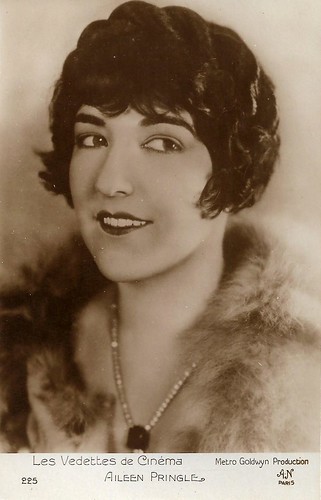
French postcard in the Les Vedettes de Cinéma series by A.N., Paris, no. 225. Photo: Metro-Goldwyn Production.
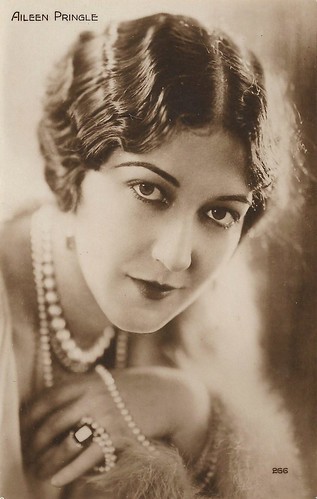
French postcard by Editions Cinémagazine, no. 266.
The three-week extra-marital love affair of a queen
Aileen Pringle was born Aileen Bisbee in 1895 within a wealthy family in San Francisco. She was educated in Europe. In 1916 she married Charles McKenzie Pringle, the son of a wealthy titled British Jamaican landowner and a member of the Privy and Legislative Councils of Jamaica.
In 1920 she started her film acting career, first at Paramount, moving to Goldwyn Pictures around 1923. She acted in films like Stolen Moments (James Vincent, 1920), starring Marguerite Namara and also with Rudolph Valentino , and Souls for Sale (Rupert Hughes, 1923), starring Eleanor Boardman in her first leading role.
She became known in 1924 for her appearance in the Goldwyn production Three Weeks (Alan Crossland, 1924) with Conrad Nagel . The film catapulted her into stardom and remains her best-known production. Based on a novel by Elinor Glyn, it focuses on the three-week extra-marital love affair of a queen, fed up with her brutal husband.
Later that year, Pringle also appeared in True As Steel (Rupert Hughes, 1924) with Huntley Gordon, and the drama His Hour (King Vidor, 1924) with John Gilbert, the follow-up to Three Weeks.
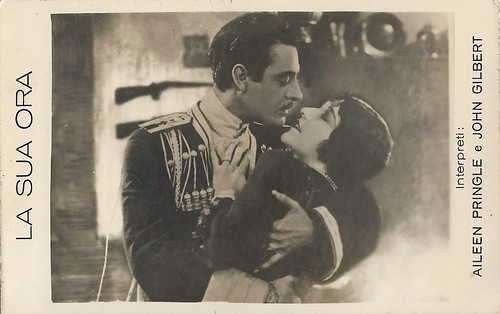
Italian postcard. Photo: MGM. John Gilbert and Aileen Pringle in His Hour (King Vidor, 1924).
A scandal on board of William Randolph Hearst's luxurious yacht
On 15 November 1924, Pringle was with columnist Louella Parsons, Charlie Chaplin , Marion Davies , Seena Owen, Jacqueline Logan and Julanne Johnston, on board of William Randolph Hearst's luxurious yacht Oneida. The occasion was a birthday party for film producer and director Thomas Ince.
She got involved in a scandal when on 19 November, Ince mysteriously died there. Although the death of Ince was ruled to have been caused by a gastro-intestinal illness, the press frenzy that followed turned the event into a Hollywood legend. However, it did not affect Pringle's career.
Several sources say that Pringle regularly treated her colleagues her haughty and dismissive on the set, which eventually affected her offer of roles. Instead, Aileen Pringle often was dubbed by the press as the 'Darling of the Intelligentsia'. She was a member of the Algonquin Round Table, and was close with writers such as Carl Van Vechten, Joseph Hergesheimer, Rupert Hughes. In particular H.L. Mencken was a lifelong friend.
The American artist Ralph Barton was also a devoted friend and used her as the model for Dorothy in his illustrations for 'Gentlemen Prefer Blondes' by Anita Loos. Her wit, keen intellect and sparkling personality made her a sought-after companion.
After her 1926 divorce from Charles Pringle, Aileen further focused on her acting career. In the later 1920s, Pringle worked mostly at MGM and had either the female lead, e.g. in A Single Man (Harry Beaumont, 1929) with Lew Cody, or was the female antagonist of the plot, as in Dream of Love (Fred Niblo, 1928) with Joan Crawford and Nils Asther .
After the rise of sound film, Pringle lost her popularity. She only got extra roles in some well-known films, such as Jane Eyre (Christy Cabanne, 1934), Wife Vs. Secretary (Clarence Brown, 1936), The Last of Mrs. Cheyney (Richard Boleslawski, 1937), Nothing Sacred (William A. Wellman, 1937), The Women (George Cukor, 1939), They Died with Their Boots On (Raoul Walsh, 1941), Since You Went Away (John Cromwell, 1944) and Laura (Otto Preminger, 1944). After this, however, she retired.
In 1944 Pringle married the author James M. Cain, but the union lasted only two years and ended in divorce. She remained prosperous for the rest of her life and died in 1989 at the age of 94. In 1960, Aileen Pringle received a star on the Hollywood Walk of Fame for her contributions to the film.
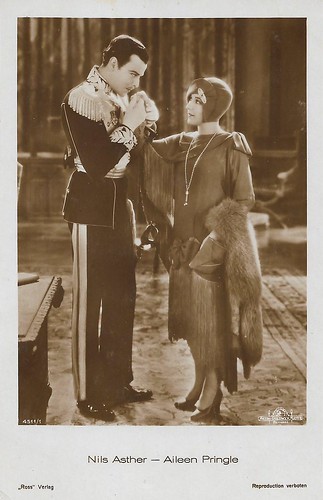
German postcard by Ross Verlag, no. 4511/1. Metro-Goldwyn-Mayer. Aileen Pringle and Nils Asther, probably in the late silent film Dream of Love (Fred Niblo, 1928). The film is considered lost.
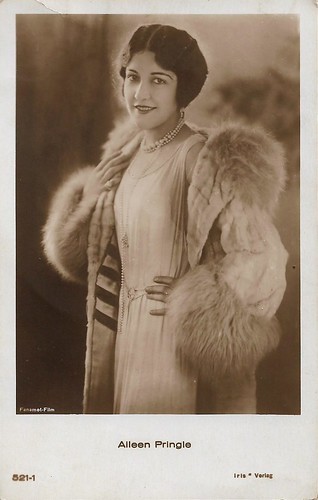
Austrian postcard by Iris Verlag, no. 521/1. Photo: Fanamet-Film.
Sources: Wikipedia and .

French postcard in the Les Vedettes de Cinéma series by A.N., Paris, no. 225. Photo: Metro-Goldwyn Production.

French postcard by Editions Cinémagazine, no. 266.
The three-week extra-marital love affair of a queen
Aileen Pringle was born Aileen Bisbee in 1895 within a wealthy family in San Francisco. She was educated in Europe. In 1916 she married Charles McKenzie Pringle, the son of a wealthy titled British Jamaican landowner and a member of the Privy and Legislative Councils of Jamaica.
In 1920 she started her film acting career, first at Paramount, moving to Goldwyn Pictures around 1923. She acted in films like Stolen Moments (James Vincent, 1920), starring Marguerite Namara and also with Rudolph Valentino , and Souls for Sale (Rupert Hughes, 1923), starring Eleanor Boardman in her first leading role.
She became known in 1924 for her appearance in the Goldwyn production Three Weeks (Alan Crossland, 1924) with Conrad Nagel . The film catapulted her into stardom and remains her best-known production. Based on a novel by Elinor Glyn, it focuses on the three-week extra-marital love affair of a queen, fed up with her brutal husband.
Later that year, Pringle also appeared in True As Steel (Rupert Hughes, 1924) with Huntley Gordon, and the drama His Hour (King Vidor, 1924) with John Gilbert, the follow-up to Three Weeks.

Italian postcard. Photo: MGM. John Gilbert and Aileen Pringle in His Hour (King Vidor, 1924).
A scandal on board of William Randolph Hearst's luxurious yacht
On 15 November 1924, Pringle was with columnist Louella Parsons, Charlie Chaplin , Marion Davies , Seena Owen, Jacqueline Logan and Julanne Johnston, on board of William Randolph Hearst's luxurious yacht Oneida. The occasion was a birthday party for film producer and director Thomas Ince.
She got involved in a scandal when on 19 November, Ince mysteriously died there. Although the death of Ince was ruled to have been caused by a gastro-intestinal illness, the press frenzy that followed turned the event into a Hollywood legend. However, it did not affect Pringle's career.
Several sources say that Pringle regularly treated her colleagues her haughty and dismissive on the set, which eventually affected her offer of roles. Instead, Aileen Pringle often was dubbed by the press as the 'Darling of the Intelligentsia'. She was a member of the Algonquin Round Table, and was close with writers such as Carl Van Vechten, Joseph Hergesheimer, Rupert Hughes. In particular H.L. Mencken was a lifelong friend.
The American artist Ralph Barton was also a devoted friend and used her as the model for Dorothy in his illustrations for 'Gentlemen Prefer Blondes' by Anita Loos. Her wit, keen intellect and sparkling personality made her a sought-after companion.
After her 1926 divorce from Charles Pringle, Aileen further focused on her acting career. In the later 1920s, Pringle worked mostly at MGM and had either the female lead, e.g. in A Single Man (Harry Beaumont, 1929) with Lew Cody, or was the female antagonist of the plot, as in Dream of Love (Fred Niblo, 1928) with Joan Crawford and Nils Asther .
After the rise of sound film, Pringle lost her popularity. She only got extra roles in some well-known films, such as Jane Eyre (Christy Cabanne, 1934), Wife Vs. Secretary (Clarence Brown, 1936), The Last of Mrs. Cheyney (Richard Boleslawski, 1937), Nothing Sacred (William A. Wellman, 1937), The Women (George Cukor, 1939), They Died with Their Boots On (Raoul Walsh, 1941), Since You Went Away (John Cromwell, 1944) and Laura (Otto Preminger, 1944). After this, however, she retired.
In 1944 Pringle married the author James M. Cain, but the union lasted only two years and ended in divorce. She remained prosperous for the rest of her life and died in 1989 at the age of 94. In 1960, Aileen Pringle received a star on the Hollywood Walk of Fame for her contributions to the film.

German postcard by Ross Verlag, no. 4511/1. Metro-Goldwyn-Mayer. Aileen Pringle and Nils Asther, probably in the late silent film Dream of Love (Fred Niblo, 1928). The film is considered lost.

Austrian postcard by Iris Verlag, no. 521/1. Photo: Fanamet-Film.
Sources: Wikipedia and .
Published on July 27, 2019 22:00
July 26, 2019
A gift by Didier Hanson: collectors cards by Helmstedter Margarinewerk
A week ago we received a letter from Spain. Our friend, collector Didier Hanson sent us a gift, a series of black and white German collectors cards from the 1950s. They were published by Helmstedter Margarinewerk GMBH in Helmstedt and were offered with a pound of their products 'Helma-Königin", 'Helma-nuss' and 'Echte-Helma'. The cards were published around 1955. In 1910, a certain Mr. Held from Schkeuditz near Leipzig had founded this factory in Helmstedt, on the eastern edge of the German state of Lower Saxony. After World War II the small factory could not escape the concentration of the large trusts and somewhere in the late 1950s Helmstedter Margarinewerk had to close its doors. But the collectors cards survive. For this post we selected 16 of the cards.
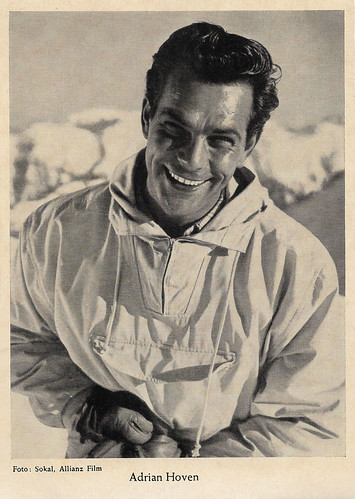
German collectors card by Helmstedter Margarinewerk GMBH, Helmstedt. Photo: Sokal / Allianz-Film. Adrian Hoven in Karneval in Weiß/Carnival in white (Hans Albin, Harry R. Sokal, 1952).
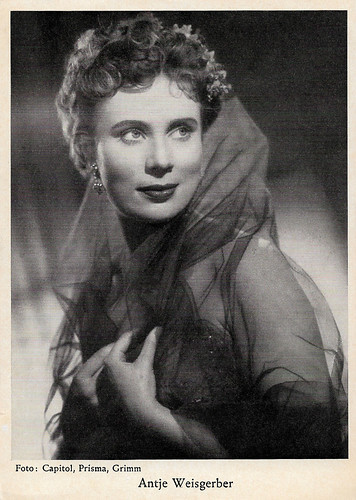
German collectors card by Helmstedter Margarinewerk GMBH, Helmstedt. Photo: Capitol / Prisma / Grimm. Antje Weisgerber in Die Stärkere/The stronger ones (Wolfgang Liebeneiner, 1953).
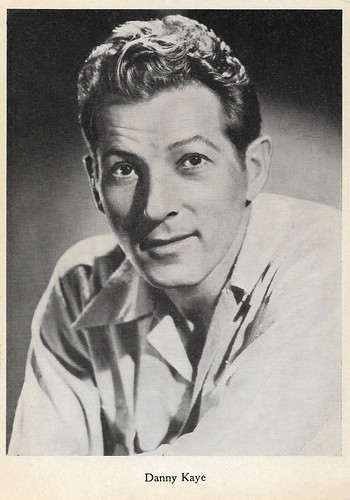
Danny Kaye . German collectors card by Helmstedter Margarinewerk GMBH, Helmstedt.
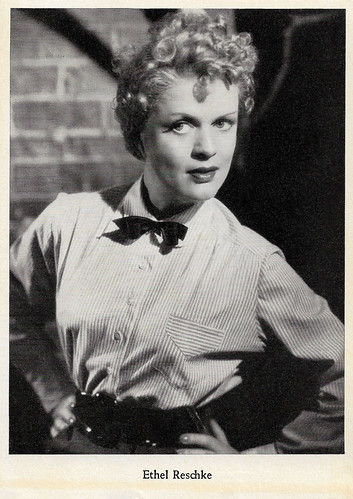
Ethel Reschke. German collectors card by Helmstedter Margarinewerk GMBH, Helmstedt.
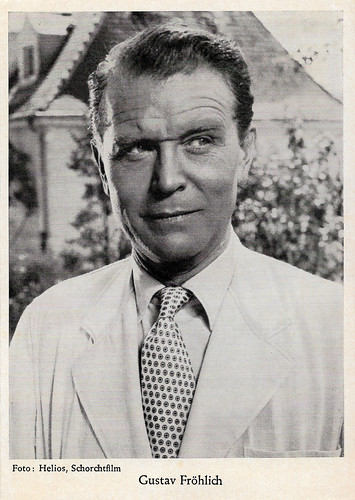
German collectors card by Helmstedter Margarinewerk GMBH, Helmstedt. Photo: Helios / Schorchtfilm. Gustav Fröhlich in Haus des Lebens/House of Life (Karl Hartl, 1952).
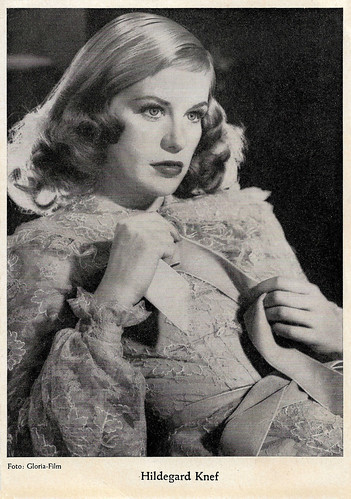
Hildegard Knef . German collectors card by Helmstedter Margarinewerk GMBH, Helmstedt. Photo: Gloria-Film.
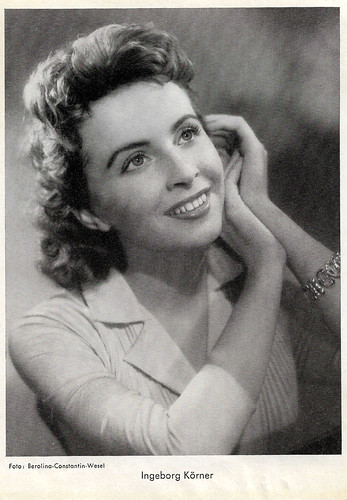
German collectors card by Helmstedter Margarinewerk GMBH, Helmstedt. Photo: Berolina / Constantin / Wesel. Ingeborg Körner in Mein Leopold (Géza von Bolváry, 1955).
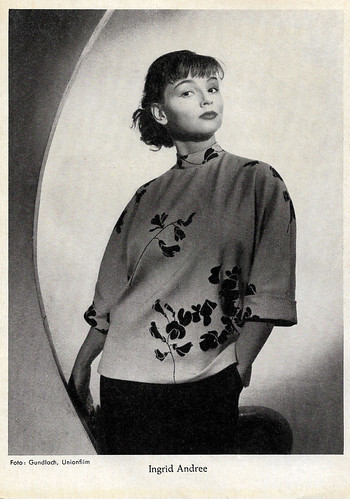
German collectors card by Helmstedter Margarinewerk GMBH, Helmstedt. Photo: Gundlach / Unionfilm. Ingrid Andree in Oh, du lieber Fridolin/Oh, you dear Fridolin (Peter Hamel, 1952). Gift by Didier Hanson.
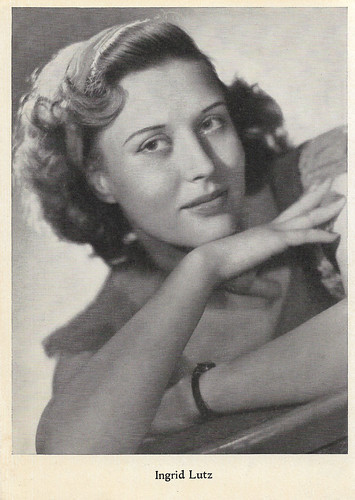
Ingrid Lutz . German collectors card by Helmstedter Margarinewerk GMBH, Helmstedt. Gift by Didier Hanson.
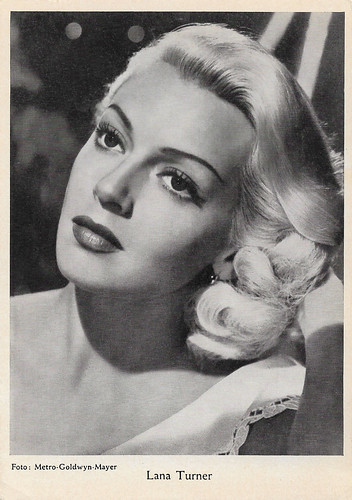
Lana Turner . German collectors card by Helmstedter Margarinewerk GMBH, Helmstedt. Photo: Metro-Goldwyn-Mayer.
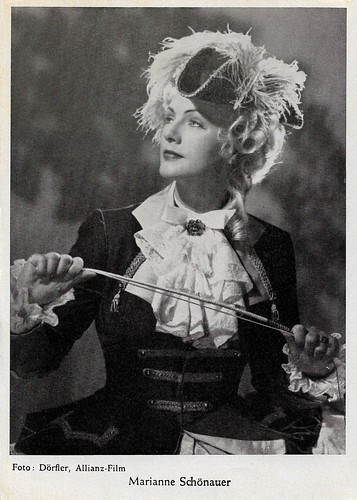
German collectors card by Helmstedter Margarinewerk GMBH, Helmstedt. Photo: Dörfler / Allianz-Film. Marianne Schönauer in Mönche, Mädchen und Panduren/Monks, girls and pandours (Ferdinand Dörfler, 1952).
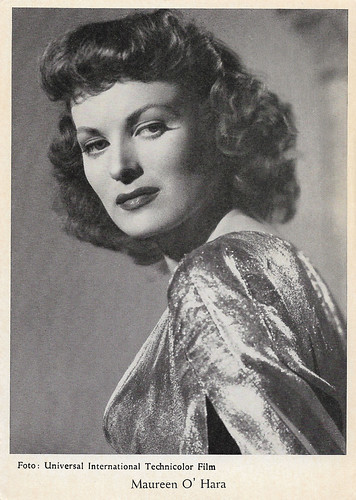
Maureen O´Hara . German collectors card by Helmstedter Margarinewerk GMBH, Helmstedt. Photo: Universal International.
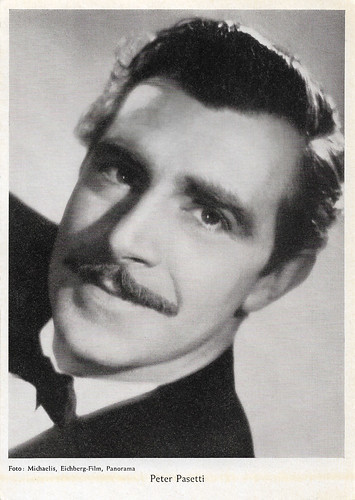
German collectors card by Helmstedter Margarinewerk GMBH, Helmstedt. Photo: Michaelis / Eichberg-Film / Panorama. Peter Pasetti in Dein Mund verspricht mir Liebe/Your mouth promises me love (Max Neufeld, 1954).
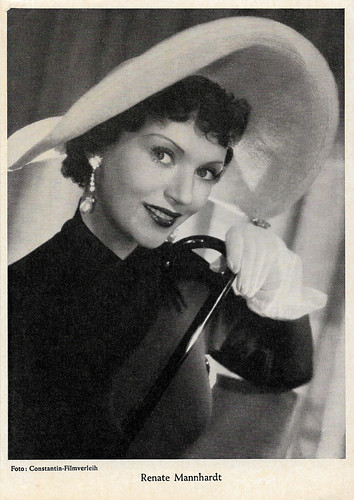
German collectors card by Helmstedter Margarinewerk GMBH, Helmstedt. Photo: Constantin-Filmverleih. Renate Mannhardt in Der keusche Josef/The chaste Josef (Carl Boese, 1953).
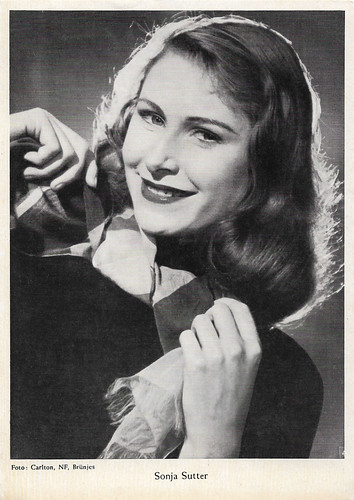
German collectors card by Helmstedter Margarinewerk GMBH, Helmstedt. Photo: Carlton / NF / Brünjes. Sonja Sutter in Meines Vaters Pferde, 1. Teil - Lena und Nicoline/My Father's Horses (Gerhard Lamprecht, 1954).
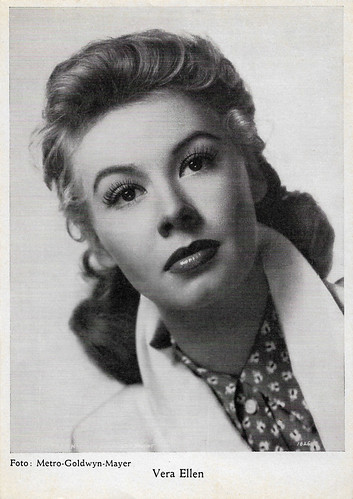
Vera Ellen . German collectors card by Helmstedter Margarinewerk GMBH, Helmstedt. Photo: Metro-Goldwyn-Mayer.
Thanks Didier!

German collectors card by Helmstedter Margarinewerk GMBH, Helmstedt. Photo: Sokal / Allianz-Film. Adrian Hoven in Karneval in Weiß/Carnival in white (Hans Albin, Harry R. Sokal, 1952).

German collectors card by Helmstedter Margarinewerk GMBH, Helmstedt. Photo: Capitol / Prisma / Grimm. Antje Weisgerber in Die Stärkere/The stronger ones (Wolfgang Liebeneiner, 1953).

Danny Kaye . German collectors card by Helmstedter Margarinewerk GMBH, Helmstedt.

Ethel Reschke. German collectors card by Helmstedter Margarinewerk GMBH, Helmstedt.

German collectors card by Helmstedter Margarinewerk GMBH, Helmstedt. Photo: Helios / Schorchtfilm. Gustav Fröhlich in Haus des Lebens/House of Life (Karl Hartl, 1952).

Hildegard Knef . German collectors card by Helmstedter Margarinewerk GMBH, Helmstedt. Photo: Gloria-Film.

German collectors card by Helmstedter Margarinewerk GMBH, Helmstedt. Photo: Berolina / Constantin / Wesel. Ingeborg Körner in Mein Leopold (Géza von Bolváry, 1955).

German collectors card by Helmstedter Margarinewerk GMBH, Helmstedt. Photo: Gundlach / Unionfilm. Ingrid Andree in Oh, du lieber Fridolin/Oh, you dear Fridolin (Peter Hamel, 1952). Gift by Didier Hanson.

Ingrid Lutz . German collectors card by Helmstedter Margarinewerk GMBH, Helmstedt. Gift by Didier Hanson.

Lana Turner . German collectors card by Helmstedter Margarinewerk GMBH, Helmstedt. Photo: Metro-Goldwyn-Mayer.

German collectors card by Helmstedter Margarinewerk GMBH, Helmstedt. Photo: Dörfler / Allianz-Film. Marianne Schönauer in Mönche, Mädchen und Panduren/Monks, girls and pandours (Ferdinand Dörfler, 1952).

Maureen O´Hara . German collectors card by Helmstedter Margarinewerk GMBH, Helmstedt. Photo: Universal International.

German collectors card by Helmstedter Margarinewerk GMBH, Helmstedt. Photo: Michaelis / Eichberg-Film / Panorama. Peter Pasetti in Dein Mund verspricht mir Liebe/Your mouth promises me love (Max Neufeld, 1954).

German collectors card by Helmstedter Margarinewerk GMBH, Helmstedt. Photo: Constantin-Filmverleih. Renate Mannhardt in Der keusche Josef/The chaste Josef (Carl Boese, 1953).

German collectors card by Helmstedter Margarinewerk GMBH, Helmstedt. Photo: Carlton / NF / Brünjes. Sonja Sutter in Meines Vaters Pferde, 1. Teil - Lena und Nicoline/My Father's Horses (Gerhard Lamprecht, 1954).

Vera Ellen . German collectors card by Helmstedter Margarinewerk GMBH, Helmstedt. Photo: Metro-Goldwyn-Mayer.
Thanks Didier!
Published on July 26, 2019 22:00
July 25, 2019
Isak Thorsen's The Rise and Fall of the Polar Bear
Every Thursday this summer, EFSP will post on a film book (I waited one day with this post because of the passing of Rutger Hauer). Last month, at the Il Cinema Ritrovato Book Fair in Bologna, I found 'Nordisk Films Kompagni 1906-1924: The Rise and Fall of the Polar Bear'. It is a scholarly study by Isak Thorsen published in the KINtop series on early cinema. The Danish Nordisk company was one of the film studios that dominated the global film market during the 1910s. How did the Danes manage to do that? Why did it go wrong with Nordisk's international aspirations in the 1920s? And my personal cliffhanger: will my earlier post on Nordisk be 'scholarly approved'?

Book cover for Isak Thorsen, 'Nordisk Films Kompagni 1906-1924. The Rise and Fall of the Polar Bear' (2017). Series KINtop Studies in early cinema, Volume 5. Publisher: John Libbey Publishing Ltd..
A European cowboy goes lion hunting
Although Isak Thorsen's book is based on his 2009 Phd Dissertation, 'The Rise and Fall of the Polar Bear' reads like an exciting and fascinating adventure novel. Central character is a man called Ole Olsen. In 1906 he founded the company which soon became an international enterprise. Until 1924, when Olsen stepped down we follow through all kinds of historical documents how he organised his film studio as a business organisation, during a period that knew more radical changes than any other era in film history.
Ole Olsen (1863-1943) must have been quite a character. He was founder, sole proprietor, then director general and general of the board, and finally rank-and-file member of the board. Olsen was the guy who took all the smart decisions. He was the typical self-made-man with many enterprises behind him. On the fairgrounds, Olsen had performed in 1895 with an x-ray machine through which you could see your own bones. From such a sensational innovation to the cinema must have been a small step for him and in 1898 Olsen was one of the first to show motion pictures in Sweden.
In 1905 he became co-owner of the second cinema in Copenhagen, Biograf-Theatret, which soon became popular among the Danes. But Olsen did not have enough film titles to show, so he decided to make his own films. On 8 January 1906, Olsen presented under the label of Nordisk a film in two parts, Maagerne fodres i Orstedsparken/Seaguls are fed in the H.C. Orstedsparken. Soon followed actualities, comedies, travelogues, industrial films, sports films etc.
In less than a year, Ole Olsen owned a printing laboratory, a studio and a branch office of Nordisk in Berlin. Like many other film pioneers Olsen was a lawless cowboy. In 1907 he bought two lions at the Haagenbeck Zoo in Hamburg and at the island of Elleore, his film crew shot a film about two big game hunters, Lovejagten/The Lion Hunt (Viggo Larsen, 1907). Although the government and animal organisations had protested, the two lions were killed for the film. The scandal in Denmark caused a world-wide success. The film was Nordisk's breakthrough to the international market.
It is fascinating to read how Nordisk grew and innovated itself. Thorsen explains that one of the reasons why Nordisk would play a decisive role in the European film industry of the 1910s was that Ole Olsen solved a fundamental problem of the industry - the enormous overproduction of films. Nordisk became one of the first film companies to base major parts of its production on multiple-reel films. It lead to a sweeping revolution in the production, distribution and exhibition of films.
Another Danish studio, Fotorama, presented a white slave trade drama with the exceptional length of 706 metres, ca. 35 minutes. It was a huge success in Copenhagen. Again Olsen acted as a cowboy in the Wild West and let his director August Blom copy the film, scene for scene. Less then four months later, Nordisk presented a nearly identical film Den hvide slavehandel/The White Slave Trade (August Blom, 1910), same title, same length, even same camera angles. And of course Nordisk's version became the international hit.
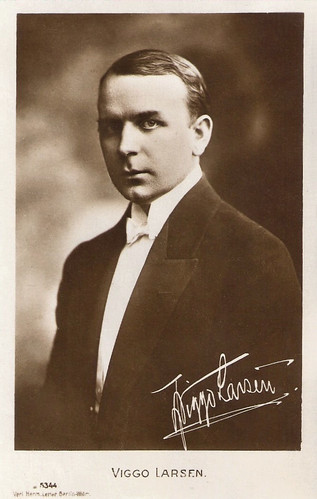
Viggo Larsen . German postcard by Verlag Herm. Leiser, Berlin, no. 5344.
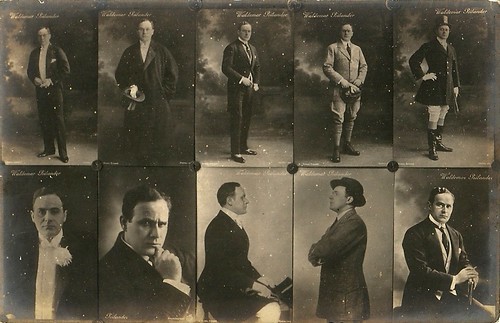
Valdemar Psilander . German postcard. Psilander appeared in his first Nordisk Film feature, Ved fængslets port/Temptations of a Great City (August Blom, 1911). He made more than eighty Nordisk Film features and was considered to be one of the greatest (and best paid) film stars of his time.
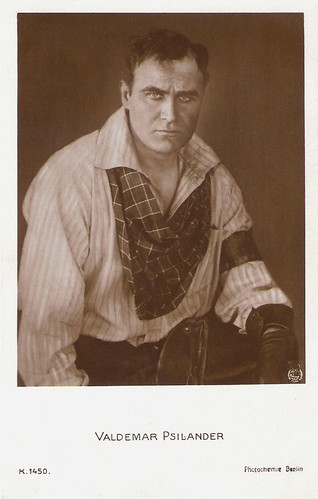
German postcard by Photochemie, Berlin, K. 1450. Photo: Nordisk Film. Valdemar Psilander in Manden uden Fremtid (Holger-Madsen, 1916). The German title was Prinz im Exil (Prince in exile).
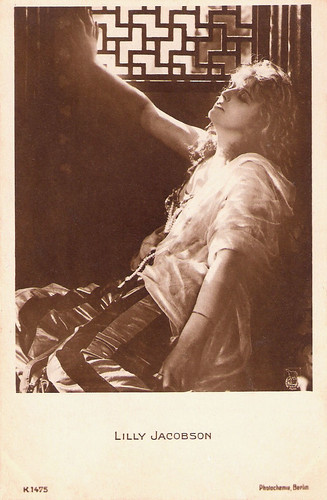
German postcard by Photochemie, Berlin, no. K. 1475. Photo: Nordisk. Lilly Jacobson in Maharadjahens Yndlingshustru/The Maharaja’s Favourite Wife (Robert Dinesen, Svend Gade, 1917).
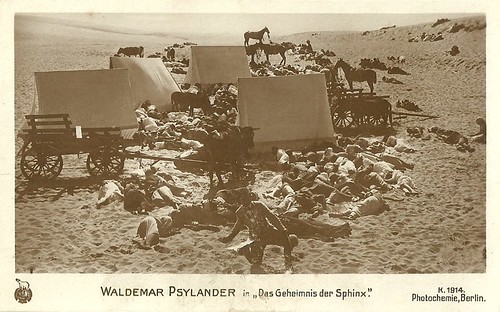
German postcard by Photochemie, Berlin, no. K 1914. Photo: Nordisk. Valdemar Psilander in Das Geheimnis der Sphinx, German release title for Sfinxens Hemmelighed/The Secret of the Desert (Robert Dinesen, 1918).
The fall of the polar bear
What caused Nordisk's demise? Several scholars wrote that the quality of the Nordisk films caused the fall of the polar bear. As a true scholar, Isak Thorsen adds some question marks to this point of view.
In 1913, Olsen himself wrote a circular to his directors in which he warned them that their productions had become "weaker than ever before". He wrote that he was prepared to sack the whole staff unless the directors produced better work, which was "worthy of the company standards". In 1913, American films had begun to gain a foothold in the European cinemas and nearby in Sweden, Scandinavian directors like Mauritz Stiller, Victor Sjöström and Benjamin Christensen had started to make their masterpieces which received much acclaim.
But still, Thorsen says no scholar can prove that the quality of the Nordisk films really went downhill in these years, simply because only a small part of the films has survived. In fact he shows based on many documents that in fact Nordisk did pretty well economically during the war years. In 1918 Nordisk produced 65 films and that's not bad indeed. But two years later the studio produced only 12 films and in the following years even less. What was the reason?
In the post-war years, Nordisk suffered from the loss of the Russian market. And Olsen's grand plan for taking control of UFA in association with the American Famous Players fell flat. The studio lost control over its most important markets and therefore Olsen decided to quit his studio in 1924.
So not the poor quality of the films caused the downfall of Nordisk as an international enterprise, but the changing international situation. Isak Thorsen's impressive book stops in 1924 but if you want to know what happened with the Polar Bear in the following decades, please read our earlier post on Nordisk.
And yes, I could not find many mistakes in our little post after reading this well documented study.
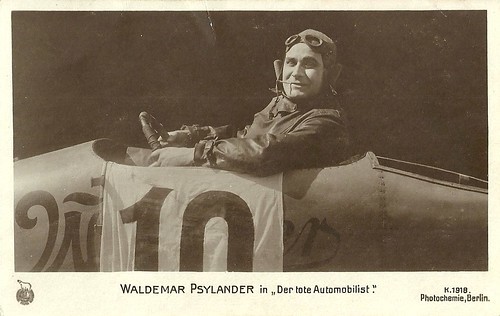
German postcard by Photochemie, Berlin, no. K. 1918. Photo: Nordisk Film Co. Valdemar Psilander in Favoriten (Robert Dinesen, 1917), released in Germany as Der tote Automobilist (The dead driver).
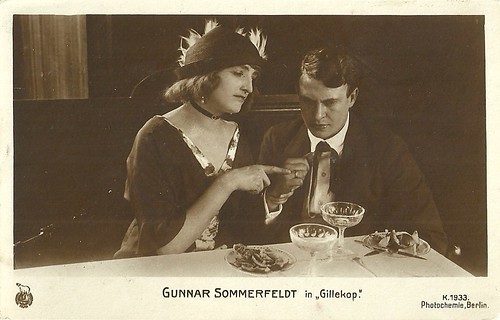
German postcard by Photochemie, Berlin, no. K.1933. Photo: Nordisk Film Co. Gunnar Sommerfeldt in Gillekop (August Blom, 1919). The script was written by Carl-Theodor Dreyer, based on a novel by Harald Tandrup.
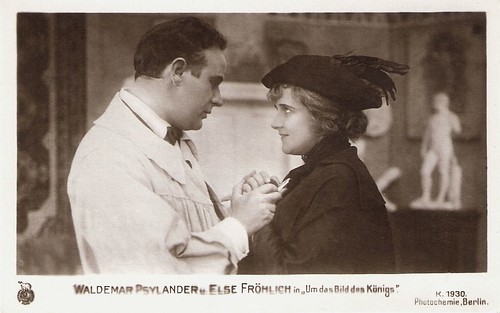
German postcard by Photochemie, Berlin, no. K. 1943. Photo: Nordisk Films. Valdemar Psilander and Else Fröhlich in Rytterstatuen (A.W. Sandberg, 1919), Its German release title was Um das Bild des Königs (For the king's statue).
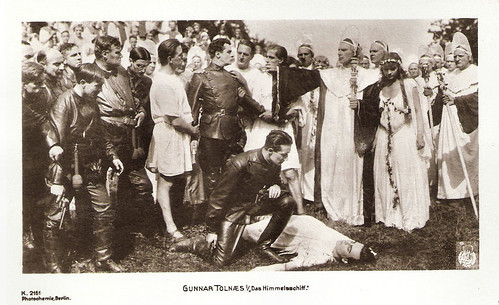
German postcard by Photochemie, Berlin, no. K. 2161. Photo: Nordisk. Publicity still for Himmelskibet/Das Himmelschiff/A Trip to Mars (Holger-Madsen, 1918) with Gunnar Tolnaes as Avanti Planetaros, Philip Bech as the Martian leader, Lilly Jacobsson as Marya, the Martian leader's daughter, Alf Blütecher (kneeling) as his friend Dr. Krafft and Nils Asther as the fallen Martian.
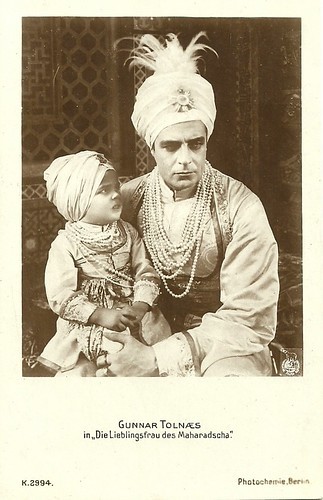
German postcard by Photochemie, Berlin, no. K. 2994. Photo: Nordisk. Gunnar Tolnaess in Maharadjahens Yndlingshustru/The Maharaja’s Favourite Wife (Robert Dinesen, Svend Gade, 1917) or one of its sequels.
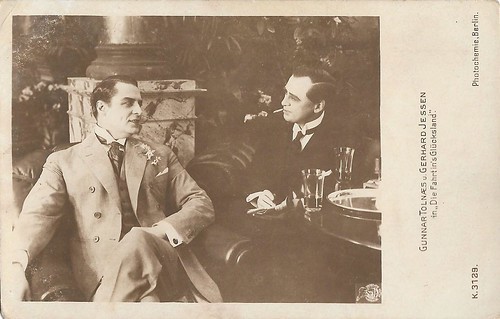
German postcard by Photochemie, Berlin, no. K. 3129. Photo: Nordisk Film Co. Gunnar Tolnaess and Gerhard Jessen in Lykkelandet (Emanuel Gregers, 1919), released in Germany as Die Fahrt ins Glücksland (The trip to the lucky country).
In 1915, Gunnar Tolnaess had moved from Sweden to Denmark, where he was offered a contract at the Nordisk studio. He was immediately successful with Doktor X/Doctor X (Robert Dinesen, 1915). Nordisk hoped that Tolnaes would become as popular as their biggest star, Valdemar Psilander .
Among Tolnaes' successes were Maharadjahens Yndlingshustru I/The Maharajah's Favourite Wife I (Robert Dinesen, 1917), Den mystiske tjener/The mysterious servant (A.W. Sandberg, 1917) and the Science-Fiction film Himmelskibet/A Trip to Mars (Holger Madsen, 1918).
In the 1920s, Gunnar Tolnaess often worked with famous Danish director A.W. Sandberg.

Book cover for Isak Thorsen, 'Nordisk Films Kompagni 1906-1924. The Rise and Fall of the Polar Bear' (2017). Series KINtop Studies in early cinema, Volume 5. Publisher: John Libbey Publishing Ltd..
A European cowboy goes lion hunting
Although Isak Thorsen's book is based on his 2009 Phd Dissertation, 'The Rise and Fall of the Polar Bear' reads like an exciting and fascinating adventure novel. Central character is a man called Ole Olsen. In 1906 he founded the company which soon became an international enterprise. Until 1924, when Olsen stepped down we follow through all kinds of historical documents how he organised his film studio as a business organisation, during a period that knew more radical changes than any other era in film history.
Ole Olsen (1863-1943) must have been quite a character. He was founder, sole proprietor, then director general and general of the board, and finally rank-and-file member of the board. Olsen was the guy who took all the smart decisions. He was the typical self-made-man with many enterprises behind him. On the fairgrounds, Olsen had performed in 1895 with an x-ray machine through which you could see your own bones. From such a sensational innovation to the cinema must have been a small step for him and in 1898 Olsen was one of the first to show motion pictures in Sweden.
In 1905 he became co-owner of the second cinema in Copenhagen, Biograf-Theatret, which soon became popular among the Danes. But Olsen did not have enough film titles to show, so he decided to make his own films. On 8 January 1906, Olsen presented under the label of Nordisk a film in two parts, Maagerne fodres i Orstedsparken/Seaguls are fed in the H.C. Orstedsparken. Soon followed actualities, comedies, travelogues, industrial films, sports films etc.
In less than a year, Ole Olsen owned a printing laboratory, a studio and a branch office of Nordisk in Berlin. Like many other film pioneers Olsen was a lawless cowboy. In 1907 he bought two lions at the Haagenbeck Zoo in Hamburg and at the island of Elleore, his film crew shot a film about two big game hunters, Lovejagten/The Lion Hunt (Viggo Larsen, 1907). Although the government and animal organisations had protested, the two lions were killed for the film. The scandal in Denmark caused a world-wide success. The film was Nordisk's breakthrough to the international market.
It is fascinating to read how Nordisk grew and innovated itself. Thorsen explains that one of the reasons why Nordisk would play a decisive role in the European film industry of the 1910s was that Ole Olsen solved a fundamental problem of the industry - the enormous overproduction of films. Nordisk became one of the first film companies to base major parts of its production on multiple-reel films. It lead to a sweeping revolution in the production, distribution and exhibition of films.
Another Danish studio, Fotorama, presented a white slave trade drama with the exceptional length of 706 metres, ca. 35 minutes. It was a huge success in Copenhagen. Again Olsen acted as a cowboy in the Wild West and let his director August Blom copy the film, scene for scene. Less then four months later, Nordisk presented a nearly identical film Den hvide slavehandel/The White Slave Trade (August Blom, 1910), same title, same length, even same camera angles. And of course Nordisk's version became the international hit.

Viggo Larsen . German postcard by Verlag Herm. Leiser, Berlin, no. 5344.

Valdemar Psilander . German postcard. Psilander appeared in his first Nordisk Film feature, Ved fængslets port/Temptations of a Great City (August Blom, 1911). He made more than eighty Nordisk Film features and was considered to be one of the greatest (and best paid) film stars of his time.

German postcard by Photochemie, Berlin, K. 1450. Photo: Nordisk Film. Valdemar Psilander in Manden uden Fremtid (Holger-Madsen, 1916). The German title was Prinz im Exil (Prince in exile).

German postcard by Photochemie, Berlin, no. K. 1475. Photo: Nordisk. Lilly Jacobson in Maharadjahens Yndlingshustru/The Maharaja’s Favourite Wife (Robert Dinesen, Svend Gade, 1917).

German postcard by Photochemie, Berlin, no. K 1914. Photo: Nordisk. Valdemar Psilander in Das Geheimnis der Sphinx, German release title for Sfinxens Hemmelighed/The Secret of the Desert (Robert Dinesen, 1918).
The fall of the polar bear
What caused Nordisk's demise? Several scholars wrote that the quality of the Nordisk films caused the fall of the polar bear. As a true scholar, Isak Thorsen adds some question marks to this point of view.
In 1913, Olsen himself wrote a circular to his directors in which he warned them that their productions had become "weaker than ever before". He wrote that he was prepared to sack the whole staff unless the directors produced better work, which was "worthy of the company standards". In 1913, American films had begun to gain a foothold in the European cinemas and nearby in Sweden, Scandinavian directors like Mauritz Stiller, Victor Sjöström and Benjamin Christensen had started to make their masterpieces which received much acclaim.
But still, Thorsen says no scholar can prove that the quality of the Nordisk films really went downhill in these years, simply because only a small part of the films has survived. In fact he shows based on many documents that in fact Nordisk did pretty well economically during the war years. In 1918 Nordisk produced 65 films and that's not bad indeed. But two years later the studio produced only 12 films and in the following years even less. What was the reason?
In the post-war years, Nordisk suffered from the loss of the Russian market. And Olsen's grand plan for taking control of UFA in association with the American Famous Players fell flat. The studio lost control over its most important markets and therefore Olsen decided to quit his studio in 1924.
So not the poor quality of the films caused the downfall of Nordisk as an international enterprise, but the changing international situation. Isak Thorsen's impressive book stops in 1924 but if you want to know what happened with the Polar Bear in the following decades, please read our earlier post on Nordisk.
And yes, I could not find many mistakes in our little post after reading this well documented study.

German postcard by Photochemie, Berlin, no. K. 1918. Photo: Nordisk Film Co. Valdemar Psilander in Favoriten (Robert Dinesen, 1917), released in Germany as Der tote Automobilist (The dead driver).

German postcard by Photochemie, Berlin, no. K.1933. Photo: Nordisk Film Co. Gunnar Sommerfeldt in Gillekop (August Blom, 1919). The script was written by Carl-Theodor Dreyer, based on a novel by Harald Tandrup.

German postcard by Photochemie, Berlin, no. K. 1943. Photo: Nordisk Films. Valdemar Psilander and Else Fröhlich in Rytterstatuen (A.W. Sandberg, 1919), Its German release title was Um das Bild des Königs (For the king's statue).

German postcard by Photochemie, Berlin, no. K. 2161. Photo: Nordisk. Publicity still for Himmelskibet/Das Himmelschiff/A Trip to Mars (Holger-Madsen, 1918) with Gunnar Tolnaes as Avanti Planetaros, Philip Bech as the Martian leader, Lilly Jacobsson as Marya, the Martian leader's daughter, Alf Blütecher (kneeling) as his friend Dr. Krafft and Nils Asther as the fallen Martian.

German postcard by Photochemie, Berlin, no. K. 2994. Photo: Nordisk. Gunnar Tolnaess in Maharadjahens Yndlingshustru/The Maharaja’s Favourite Wife (Robert Dinesen, Svend Gade, 1917) or one of its sequels.

German postcard by Photochemie, Berlin, no. K. 3129. Photo: Nordisk Film Co. Gunnar Tolnaess and Gerhard Jessen in Lykkelandet (Emanuel Gregers, 1919), released in Germany as Die Fahrt ins Glücksland (The trip to the lucky country).
In 1915, Gunnar Tolnaess had moved from Sweden to Denmark, where he was offered a contract at the Nordisk studio. He was immediately successful with Doktor X/Doctor X (Robert Dinesen, 1915). Nordisk hoped that Tolnaes would become as popular as their biggest star, Valdemar Psilander .
Among Tolnaes' successes were Maharadjahens Yndlingshustru I/The Maharajah's Favourite Wife I (Robert Dinesen, 1917), Den mystiske tjener/The mysterious servant (A.W. Sandberg, 1917) and the Science-Fiction film Himmelskibet/A Trip to Mars (Holger Madsen, 1918).
In the 1920s, Gunnar Tolnaess often worked with famous Danish director A.W. Sandberg.
Published on July 25, 2019 22:00
July 24, 2019
Rutger Hauer (1944-2019): our hero is dead
Last Friday, 19 July 2019, Rutger Hauer has passed away at his home in Beetsterzwaag, following a short illness. The blonde, blue-eyed, tall and handsome Dutch actor played everything - from romantic leads to action heroes to sinister villains. During the 1970s, he had his international breakthrough with the Dutch films by Paul Verhoeven and later he became a cult star with Blade Runner (1982), The Hitcher (1986) and Blind Fury (1989). Before that he was the hero of many Dutch kids in the classic TV series Floris (1969), also directed by Paul Verhoeven. Hauer was 75.
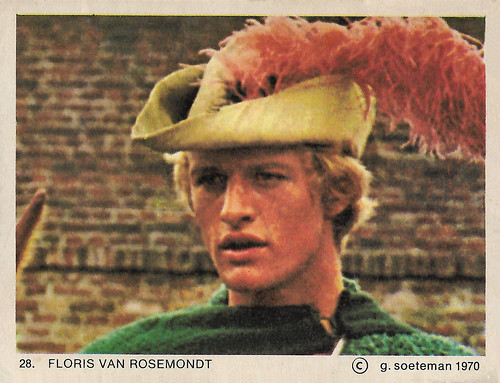
Dutch collectors card, no. 28, 1970. Photo: Gerard Soeteman. Rutger Hauer in the TV series Floris (Paul Verhoeven, 1969).
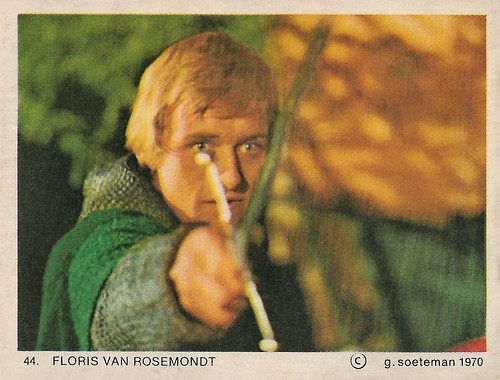
Dutch collectors card, no. 44, 1970. Photo: Gerard Soeteman. Rutger Hauer in the TV series Floris (Paul Verhoeven, 1969).
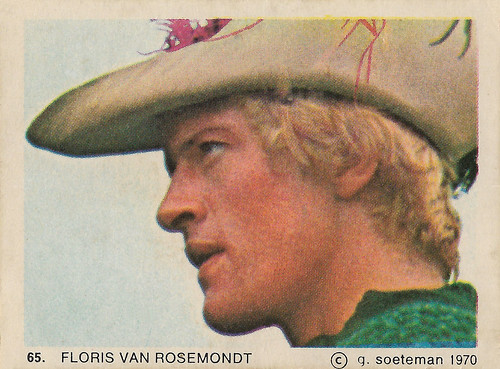
Dutch collectors card, no. 65, 1970. Photo: Gerard Soeteman. Rutger Hauer in the TV series Floris (Paul Verhoeven, 1969).
A bit of a rebel
Rutger Oelsen Hauer was born in Breukelen, the Netherlands in 1944 in a family of actors. His parents, Arend Hauer and Teunke Hauer-Mellema, operated an acting school in Amsterdam. Because both his parents were often off working, he and his three sisters were raised by a nanny.
A bit of a rebel during his childhood, he chafed at the rules and rigours of school and was often getting into mischief. His grandfather had been the captain of a schooner and at age 15, Hauer ran away to work on a freighter for a year. Upon his return he attended night school and started working in the construction industry. When he again bombed at school, his parents enrolled him in drama classes.
He then worked five years for the Noorder Compagnie, a Dutch stage company. His screen career began in 1969 as the hero in the popular Dutch television series Floris (Paul Verhoeven, 1969), a medieval action drama. The role of the dashing knight made him famous in the low countries, and Hauer reprised his role for the German remake Floris von Rosemund (Ferry Radax, 1975).
Hauer's career changed course when Paul Verhoeven cast him in Turks fruit/Turkish Delight (1973) opposite Monique van de Ven. The sensual and tragic romance found box-office favour abroad as well as at home. It brought him several international offers. In Germany he made the exploitation film Pusteblume//The Blonde Love Machine (Adrian Hoven, 1974) and the thriller Das Amulett des Todes/Cold Blood (Ralf Gregan, Günter Vaessen, 1975) with Vera Tschechowa .
Hauer was invited to make his English-language debut in the British film The Wilby Conspiracy (Ralph Nelson, 1975) opposite Sidney Poitier and Michael Caine . Set in South Africa, the film was an action-drama with a focus on apartheid. Hauer's supporting role, however, was barely noticed in Hollywood, and he returned to Dutch films.
Hauer reunited with Monique van de Ven and Paul Verhoeven for Keetje Tippel/Katie Tippel (1975). He worked again with Verhoeven on Soldaat van Oranje/Soldier of Orange (1977), and Spetters (1980), both with Jeroen Krabbé. Especially Soldaat van Oranje was a huge success and was instrumental in his international breakthrough.
After making a television series and five films directed by Paul Verhoeven, they had a falling-out on their last combined effort, the troubled Flesh+Blood (1985). The two would never work again. According to IMDb , Hauer turned down roles in both Verhoeven’s Robocop (1987) and Zwartboek/Blackbook (2006).
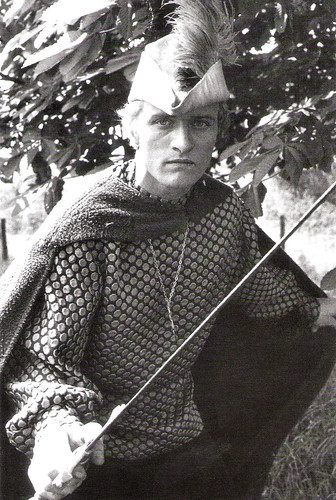
Dutch postcard by N.A.A., 2000. Photo: Rutger Hauer in Floris (Paul Verhoeven, 1969).
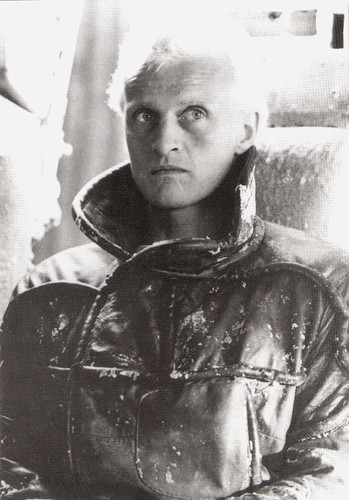
American postcard by Zoetrope Images LTD, Boston, Mass., no. 405. Photo: Rutger Hauer in Blade Runner (Ridley Scott, 1982).
Tears in Rain
Rutger Hauer made his American debut in the Sylvester Stallone film Nighthawks (Bruce Malmuth, 1981) as a psychopathic and cold-blooded terrorist named Wulfgar. The following year, he appeared in arguably his most famous and acclaimed role as the eccentric and violent but sympathetic anti-hero Roy Batty in the science fiction thriller Blade Runner (Ridley Scott, 1982), in which role he improvised the famous tears in rain soliloquy.
Hauer went on to play the adventurer courting Theresa Russell in Eureka (Nicolas Roeg, 1983), the investigative reporter opposite John Hurt in The Osterman Weekend (Sam Peckinpah, 1983), and the knight paired with Michelle Pfeiffer in Ladyhawke (Richard Donner, 1985). He continued to make an impression on audiences in The Hitcher (Robert Harmon, 1986), in which he played a mysterious hitchhiker intent on murdering a lone motorist and anyone else in his way.
During the late 1980s and early 1990s, Rutger Hauer became well known to the British public for a series of humorous Guinness commercials where he is clad in black. His appearance is credited for an increase in sales of Guinness.
His films included Wanted: Dead or Alive (Gary Sherman, 1986), La leggenda del santo bevitore/The Legend of the Holy Drinker (Ermanno Olmi, 1989), the martial arts action adventure Blind Fury (Philip Noyce, 1989) and the Science-Fiction adventure The Blood of Heroes (David Webb Peoples, 1990).
Hauer acted in several British and American television productions, including Inside the Third Reich (Marvin J. Chomsky, 1982) as Hitler’s young architect Albert Speer, Escape from Sobibor (Jack Gold, 1987) for which he received a Golden Globe Award for Best Supporting Actor, Fatherland (Christopher Menaul, 1994), Amelia Earhart: The Final Flight (Yves Simoneau, 1994), Hostile Waters (David Drury, 1997), Merlin (1998), The 10th Kingdom (2000), Smallville (2003), Alias (J.J. Abrams, 2003), and Salem's Lot (Mikael Salomon, 2004).
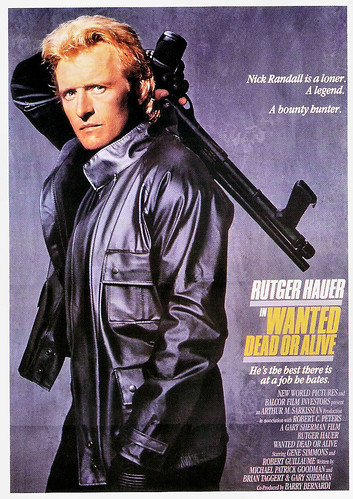
French postcard by Editions Avant Garde, no. P549. Poster for Wanted: Dead or Alive (Gary Sherman, 1986).
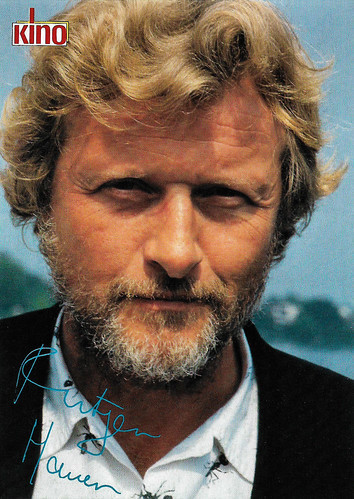
German autograph card by Kino, 1989.
True Blood
After years of mainly television and straight-to-video movies, Rutger Hauer made a kind of come-back to the cinema in the new century. He played an assassin in Confessions of a Dangerous Mind (George Clooney, 2002), a villainous cardinal with influential power in (Frank Miller, Robert Rodriguez, 2005) and a devious corporate executive running Wayne Enterprises in the blockbuster Batman Begins (Christopher Nolan, 2005).
In 2007, he published his autobiography 'All Those Moments: Stories of Heroes, Villains, Replicants, and Blade Runners' (co-written with Patrick Quinlan), where he discusses many of his roles. He returned to the Dutch cinema in films like Bride Flight (Ben Sombogaart, 2008), Oogverblindend/Dazzle (Cyrus Frisch, 2009), Black Butterflies (Paula van der Oest, 2011) with Carice van Houten, and as Freddie Heineken in De Heineken Ontvoering/The Heineken Kidnapping (Maarten Treurniet, 2011).
2011 turned out to be one of Hauer’s busiest years that was also highlighted by major parts as the Flemish painter Pieter Bruegel in The Mill & the Cross (Lech Majewski, 2011), a violent hobo in the neo-exploitation thriller Hobo With a Shotgun (Jason Eisener, 2011), and an undertaker in the horror film The Rite (Mikael Håfström, 2011).
More recently he played Abraham Van Helsing in Dracula/Dracula 3D (Dario Argento, 2012) starring Thomas Kretschman, Michelangelo in the TV film Michelangelo - Il cuore e la pietra/Michelangelo (Giacomo Gatti, 2012), Maciste, a retired Mr. Universe in Il Futuro/The Future (Alicia Scherson, 2013), and the vampire Niall Brigant in the hit series True Blood (2013).
Hauer remained making films till his death. He appeared in the French-American Western The Sisters Brothers (Jacques Audiard, 2018) with John C. Reilly, Jake Gyllenhaal and Joaquin Phoenix. The film won the Silver Lion for Best Direction at the Venice International Film Festival. It was the final feature film starring Rutger Hauer released during his lifetime.
Posthumously released will be three films with Hauer, which are now in post production: Viy 2: Journey to China, John the Constant and Break.
Hauer was a dedicated environmentalist. He fought for the release of Sea Shepherd Conservation Society leader, Paul Watson, who was convicted in 1994 for sinking a Norwegian whaling vessel. Hauer had also established an AIDS awareness organisation called the Rutger Hauer Starfish Association.
Since 1969 Rutger Hauer's partner was painter and sculptor Ineke ten Cate, whom he married in 1985. From a brief earlier marriage, he had a daughter, actress Ayesha Hauer (1966). His grandson is fashion model Leandro Maeder.
Official Trailer Flesh + Blood (1985). Source: Old Hollywood Trailers (YouTube).
Theatrical Trailer Blade Runner: Director's Cut (1992). Source: Cinematic Trailers (YouTube).
Trailer De Heineken Ontvoering/The Heineken Kidnapping (2011). Source: Afilmtube (YouTube).
Sources: Sandra Brennan (AllMovie), Wikipedia (English and Dutch) and .

Dutch collectors card, no. 28, 1970. Photo: Gerard Soeteman. Rutger Hauer in the TV series Floris (Paul Verhoeven, 1969).

Dutch collectors card, no. 44, 1970. Photo: Gerard Soeteman. Rutger Hauer in the TV series Floris (Paul Verhoeven, 1969).

Dutch collectors card, no. 65, 1970. Photo: Gerard Soeteman. Rutger Hauer in the TV series Floris (Paul Verhoeven, 1969).
A bit of a rebel
Rutger Oelsen Hauer was born in Breukelen, the Netherlands in 1944 in a family of actors. His parents, Arend Hauer and Teunke Hauer-Mellema, operated an acting school in Amsterdam. Because both his parents were often off working, he and his three sisters were raised by a nanny.
A bit of a rebel during his childhood, he chafed at the rules and rigours of school and was often getting into mischief. His grandfather had been the captain of a schooner and at age 15, Hauer ran away to work on a freighter for a year. Upon his return he attended night school and started working in the construction industry. When he again bombed at school, his parents enrolled him in drama classes.
He then worked five years for the Noorder Compagnie, a Dutch stage company. His screen career began in 1969 as the hero in the popular Dutch television series Floris (Paul Verhoeven, 1969), a medieval action drama. The role of the dashing knight made him famous in the low countries, and Hauer reprised his role for the German remake Floris von Rosemund (Ferry Radax, 1975).
Hauer's career changed course when Paul Verhoeven cast him in Turks fruit/Turkish Delight (1973) opposite Monique van de Ven. The sensual and tragic romance found box-office favour abroad as well as at home. It brought him several international offers. In Germany he made the exploitation film Pusteblume//The Blonde Love Machine (Adrian Hoven, 1974) and the thriller Das Amulett des Todes/Cold Blood (Ralf Gregan, Günter Vaessen, 1975) with Vera Tschechowa .
Hauer was invited to make his English-language debut in the British film The Wilby Conspiracy (Ralph Nelson, 1975) opposite Sidney Poitier and Michael Caine . Set in South Africa, the film was an action-drama with a focus on apartheid. Hauer's supporting role, however, was barely noticed in Hollywood, and he returned to Dutch films.
Hauer reunited with Monique van de Ven and Paul Verhoeven for Keetje Tippel/Katie Tippel (1975). He worked again with Verhoeven on Soldaat van Oranje/Soldier of Orange (1977), and Spetters (1980), both with Jeroen Krabbé. Especially Soldaat van Oranje was a huge success and was instrumental in his international breakthrough.
After making a television series and five films directed by Paul Verhoeven, they had a falling-out on their last combined effort, the troubled Flesh+Blood (1985). The two would never work again. According to IMDb , Hauer turned down roles in both Verhoeven’s Robocop (1987) and Zwartboek/Blackbook (2006).

Dutch postcard by N.A.A., 2000. Photo: Rutger Hauer in Floris (Paul Verhoeven, 1969).

American postcard by Zoetrope Images LTD, Boston, Mass., no. 405. Photo: Rutger Hauer in Blade Runner (Ridley Scott, 1982).
Tears in Rain
Rutger Hauer made his American debut in the Sylvester Stallone film Nighthawks (Bruce Malmuth, 1981) as a psychopathic and cold-blooded terrorist named Wulfgar. The following year, he appeared in arguably his most famous and acclaimed role as the eccentric and violent but sympathetic anti-hero Roy Batty in the science fiction thriller Blade Runner (Ridley Scott, 1982), in which role he improvised the famous tears in rain soliloquy.
Hauer went on to play the adventurer courting Theresa Russell in Eureka (Nicolas Roeg, 1983), the investigative reporter opposite John Hurt in The Osterman Weekend (Sam Peckinpah, 1983), and the knight paired with Michelle Pfeiffer in Ladyhawke (Richard Donner, 1985). He continued to make an impression on audiences in The Hitcher (Robert Harmon, 1986), in which he played a mysterious hitchhiker intent on murdering a lone motorist and anyone else in his way.
During the late 1980s and early 1990s, Rutger Hauer became well known to the British public for a series of humorous Guinness commercials where he is clad in black. His appearance is credited for an increase in sales of Guinness.
His films included Wanted: Dead or Alive (Gary Sherman, 1986), La leggenda del santo bevitore/The Legend of the Holy Drinker (Ermanno Olmi, 1989), the martial arts action adventure Blind Fury (Philip Noyce, 1989) and the Science-Fiction adventure The Blood of Heroes (David Webb Peoples, 1990).
Hauer acted in several British and American television productions, including Inside the Third Reich (Marvin J. Chomsky, 1982) as Hitler’s young architect Albert Speer, Escape from Sobibor (Jack Gold, 1987) for which he received a Golden Globe Award for Best Supporting Actor, Fatherland (Christopher Menaul, 1994), Amelia Earhart: The Final Flight (Yves Simoneau, 1994), Hostile Waters (David Drury, 1997), Merlin (1998), The 10th Kingdom (2000), Smallville (2003), Alias (J.J. Abrams, 2003), and Salem's Lot (Mikael Salomon, 2004).

French postcard by Editions Avant Garde, no. P549. Poster for Wanted: Dead or Alive (Gary Sherman, 1986).

German autograph card by Kino, 1989.
True Blood
After years of mainly television and straight-to-video movies, Rutger Hauer made a kind of come-back to the cinema in the new century. He played an assassin in Confessions of a Dangerous Mind (George Clooney, 2002), a villainous cardinal with influential power in (Frank Miller, Robert Rodriguez, 2005) and a devious corporate executive running Wayne Enterprises in the blockbuster Batman Begins (Christopher Nolan, 2005).
In 2007, he published his autobiography 'All Those Moments: Stories of Heroes, Villains, Replicants, and Blade Runners' (co-written with Patrick Quinlan), where he discusses many of his roles. He returned to the Dutch cinema in films like Bride Flight (Ben Sombogaart, 2008), Oogverblindend/Dazzle (Cyrus Frisch, 2009), Black Butterflies (Paula van der Oest, 2011) with Carice van Houten, and as Freddie Heineken in De Heineken Ontvoering/The Heineken Kidnapping (Maarten Treurniet, 2011).
2011 turned out to be one of Hauer’s busiest years that was also highlighted by major parts as the Flemish painter Pieter Bruegel in The Mill & the Cross (Lech Majewski, 2011), a violent hobo in the neo-exploitation thriller Hobo With a Shotgun (Jason Eisener, 2011), and an undertaker in the horror film The Rite (Mikael Håfström, 2011).
More recently he played Abraham Van Helsing in Dracula/Dracula 3D (Dario Argento, 2012) starring Thomas Kretschman, Michelangelo in the TV film Michelangelo - Il cuore e la pietra/Michelangelo (Giacomo Gatti, 2012), Maciste, a retired Mr. Universe in Il Futuro/The Future (Alicia Scherson, 2013), and the vampire Niall Brigant in the hit series True Blood (2013).
Hauer remained making films till his death. He appeared in the French-American Western The Sisters Brothers (Jacques Audiard, 2018) with John C. Reilly, Jake Gyllenhaal and Joaquin Phoenix. The film won the Silver Lion for Best Direction at the Venice International Film Festival. It was the final feature film starring Rutger Hauer released during his lifetime.
Posthumously released will be three films with Hauer, which are now in post production: Viy 2: Journey to China, John the Constant and Break.
Hauer was a dedicated environmentalist. He fought for the release of Sea Shepherd Conservation Society leader, Paul Watson, who was convicted in 1994 for sinking a Norwegian whaling vessel. Hauer had also established an AIDS awareness organisation called the Rutger Hauer Starfish Association.
Since 1969 Rutger Hauer's partner was painter and sculptor Ineke ten Cate, whom he married in 1985. From a brief earlier marriage, he had a daughter, actress Ayesha Hauer (1966). His grandson is fashion model Leandro Maeder.
Official Trailer Flesh + Blood (1985). Source: Old Hollywood Trailers (YouTube).
Theatrical Trailer Blade Runner: Director's Cut (1992). Source: Cinematic Trailers (YouTube).
Trailer De Heineken Ontvoering/The Heineken Kidnapping (2011). Source: Afilmtube (YouTube).
Sources: Sandra Brennan (AllMovie), Wikipedia (English and Dutch) and .
Published on July 24, 2019 22:00
July 23, 2019
Ila Lóth
Ila Lóth (1900-1975) was the most popular Hungarian actress of the silent screen. She starred in films by the Star Film Company and the Corvin Film Factory, and her co-star in these films was often Arisztid Olt, better known now as Béla Lugosi. In the early 1920s, she also made films for the Emelka studio in Germany. Ila Lóth acted in 35 silent films before she married in 1923 and retired. In the 1950s, she returned to the screen in small parts.
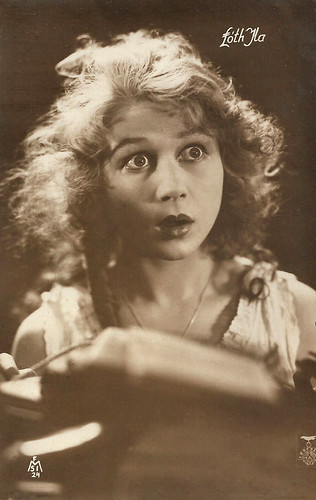
Hungarian postcard by MFSI, no 24. Photo: May. Ila Lóth in Lengyelvér/Polish Blood (Béla Balogh, 1921)
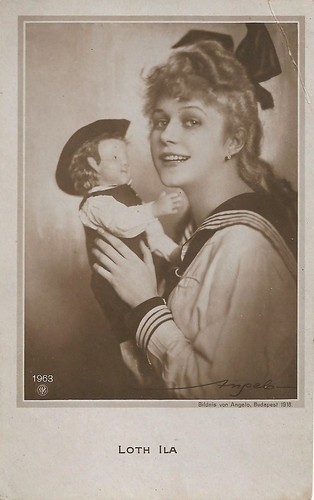
German postcard by NPG, no. 1963. Photo: Angelo , Budapest, 1930.
Dorian Gray
Ila Lóth was born as Mária Rónai in 1900 in Budapest, Hungary (Austria-Hungary). She was the daughter of István Rónai, a drawer, and Mária Horváth.
She studied at the Állami Operaház Balettiskolájában (Ballet School of the State Opera) and then she graduated from Kálmán Rózsahegyi's private acting school.
In 1916 she appeared in the film version of János vitéz/John the Hero (Eugen Illés, Tibor Rákosi, 1916) as one of the dancing fairies opposite Alfréd Deésy as the male lead.
In 1917, screenwriter József Pakots discovered her and she became a member of the Star Film Company. With her natural acting style, Ila Lóth soon became a popular star of the Hungarian silent cinema, first of all in films directed by actor-turned-director Alfréd Deésy, e.g. as the maid in Raskolnyikov/Raskolnikov (1917), Casanova (1918) with Deésy himself in the title role, and as Postáskisasszony in Lengyelvér/The Leopard (1918), opposite Bela Lugosi (as Arisztid Olt).
She also played Sybil Vane in Az élet királya/The Picture of Dorian Gray (Alfréd Deésy, 1918), based on Oscar Wilde's novel of the same name, with Norbert Dán as Dorian Gray and Bela Lugosi (as Arisztid Olt) as Lord Henry Wotton.
Also, German director Cornelius Hintner often directed her in Hungarian films, e.g. in Nebántsvirág/Mam'zelle Nitouche (Cornelius Hintner, 1918) and the comedy Egy Nagymama naplójából/Lili (Cornelius Hintner, 1918) featuring Ida Andorffy as Lili and Béla Lugosi.
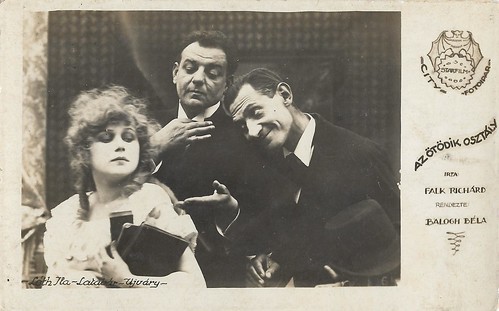
Hungarian postcard. Photo: Star Film. Ila Lóth, Árpád Latabár, and Lajos Ujváry in Az ötödik osztály (Bela Balogh, 1920). The card reads 'written by Richard Falk', but IMDb lists József Pakots as the screenwriter of the film.
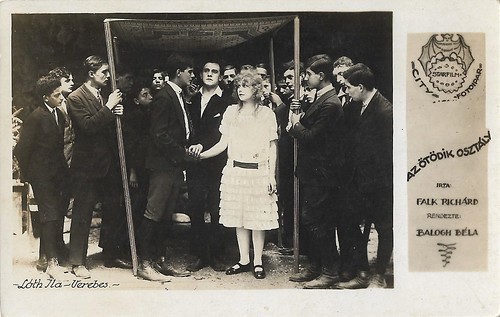
Hungarian postcard. Photo: Star Film. Ila Lóth and Ernö Verebes a.k.a. Ernst Verebes in Az ötödik osztály (Bela Balogh, 1920). The card reads 'written by Richard Falk', but IMDb lists József Pakots as the screenwriter of the film.
A Hungarian version of Mary Pickford
In 1919, Ila Lóth moved to the Corvin Film Factory, on the recommendation of Korda Sándor a.k.a. Alexander Korda. Korda directed her in the drama Yamata (Alexander Korda, 1919) and starring Gábor Rajnay as the slave Yamata.
Yamata was made for the state-owned Hungarian film industry during the Hungarian Soviet Republic, and concerns a black slave's revolt against his master. The film's apparent political leftism, along with that of Ave Caesar! (Alexander Korda, 1919), led to Korda's arrest once the Soviet Republic collapsed and he fled Hungary in 1919 during the White Terror.
Ila Lóth appeared for Corvin in several films by Béla Balogh as a naive girl with blond curls, a Hungarian version of Mary Pickford. These films included Az egyhuszasos lány/Egy dollár/One dollar (Béla Balogh, 1923), in which she starred opposite Paul Lukas , and Hegyek alján/Under the Mountains (Béla Balogh, 1920), with Iván Petrovich .
In the early 1920s, she made some Germsn silent films for the Münchner Lichtspielkunst AG (Emelka) studio in Munich, such as Der Verfluchte/The damned (Franz Osten, 1921), with Violetta Napierska , Schattenkinder des Glücks/Shadow children of happiness (Franz Osten, 1922), with Vilma Banky and Um Liebe und Thron/For Love and Crown (Franz Osten, 1922) with Ellen Kürti.
Probably her last silent film was A Lélek órása/Soul Watch (Béla Balogh, 1923), in which she starred opposite Gusztáv Vándory. On the 26th of October 1923, Ila Loth married Győző János Rohoczy Storer in Budapest and retired for a long time. All in all, Lóth acted in some 35 silent films.
From 1948 onward, she played small parts in films again. Among her films of the 1950s is the classic Liliomfi (Károly Makk, 1954) with Iván Darvas, Marianne Krencsey , Éva Ruttkai and Imre Soós . The film was shown at the Cannes Film Festival in 1955.
From the 1950s on, Ila Lóth acted on stage at the Madách Theatre. From 1960, she also appeared in some Hungarian TV films and one series, the popular historical adventure series A Tenkes kapitánya/Captain Of The Tenkes (Tamás Fejér, 1964) with Ferenc Zenthe.
In the cinema, she appeared in another Hungarian classic, Apa/Father (István Szabó, 1966) featuring Miklós Gabór. Her last feature film appearance was in Szabó's Tüzoltó utca 25./25 Fireman's Street (István Szábo, 1973) with Lucyna Winnicka and Margit Makay .
Ila Lóth passed away in 1975 in Budapest, Hungary. She is interred at the Fiumei úti Nemzeti Sírkert (National Graveyard in Fiumei Street) in Budapest. Her husband Viktorne Storer had passed away in 1952.
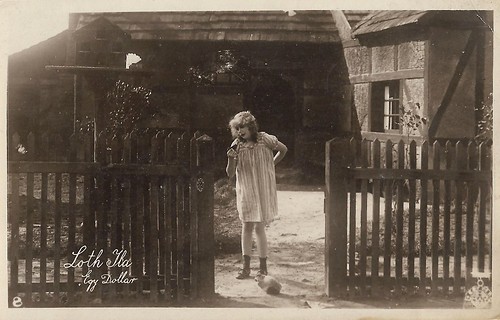
Hungarian postcard, no. 2. Photo: Corvin Film / May Film. Ila Lóth in Egy dollar/One Dollar aka Az egyhuszasos lány (Uwe Jens Krafft, 1923).
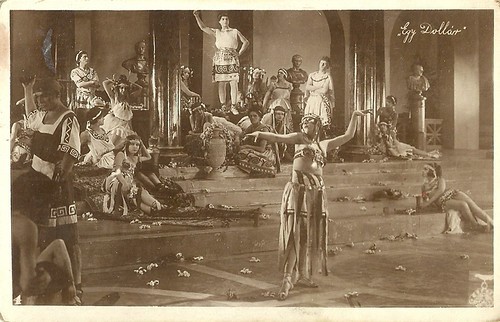
Hungarian postcard, no. 4. Photo: Corvin Film / May Film. Ila Lóth in Egy dollar/One Dollar aka Az egyhuszasos lány (Uwe Jens Krafft, 1923).
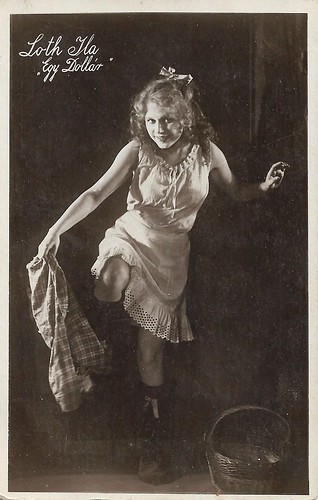
Hungarian postcard by K Ltd. Photo: Corvin Film / May Film. Ila Lóth in Egy dollar/One Dollar aka Az egyhuszasos lány (Uwe Jens Krafft, 1923).
Sources: Billion Graves, Wikipedia (Hungarian and English) and .

Hungarian postcard by MFSI, no 24. Photo: May. Ila Lóth in Lengyelvér/Polish Blood (Béla Balogh, 1921)

German postcard by NPG, no. 1963. Photo: Angelo , Budapest, 1930.
Dorian Gray
Ila Lóth was born as Mária Rónai in 1900 in Budapest, Hungary (Austria-Hungary). She was the daughter of István Rónai, a drawer, and Mária Horváth.
She studied at the Állami Operaház Balettiskolájában (Ballet School of the State Opera) and then she graduated from Kálmán Rózsahegyi's private acting school.
In 1916 she appeared in the film version of János vitéz/John the Hero (Eugen Illés, Tibor Rákosi, 1916) as one of the dancing fairies opposite Alfréd Deésy as the male lead.
In 1917, screenwriter József Pakots discovered her and she became a member of the Star Film Company. With her natural acting style, Ila Lóth soon became a popular star of the Hungarian silent cinema, first of all in films directed by actor-turned-director Alfréd Deésy, e.g. as the maid in Raskolnyikov/Raskolnikov (1917), Casanova (1918) with Deésy himself in the title role, and as Postáskisasszony in Lengyelvér/The Leopard (1918), opposite Bela Lugosi (as Arisztid Olt).
She also played Sybil Vane in Az élet királya/The Picture of Dorian Gray (Alfréd Deésy, 1918), based on Oscar Wilde's novel of the same name, with Norbert Dán as Dorian Gray and Bela Lugosi (as Arisztid Olt) as Lord Henry Wotton.
Also, German director Cornelius Hintner often directed her in Hungarian films, e.g. in Nebántsvirág/Mam'zelle Nitouche (Cornelius Hintner, 1918) and the comedy Egy Nagymama naplójából/Lili (Cornelius Hintner, 1918) featuring Ida Andorffy as Lili and Béla Lugosi.

Hungarian postcard. Photo: Star Film. Ila Lóth, Árpád Latabár, and Lajos Ujváry in Az ötödik osztály (Bela Balogh, 1920). The card reads 'written by Richard Falk', but IMDb lists József Pakots as the screenwriter of the film.

Hungarian postcard. Photo: Star Film. Ila Lóth and Ernö Verebes a.k.a. Ernst Verebes in Az ötödik osztály (Bela Balogh, 1920). The card reads 'written by Richard Falk', but IMDb lists József Pakots as the screenwriter of the film.
A Hungarian version of Mary Pickford
In 1919, Ila Lóth moved to the Corvin Film Factory, on the recommendation of Korda Sándor a.k.a. Alexander Korda. Korda directed her in the drama Yamata (Alexander Korda, 1919) and starring Gábor Rajnay as the slave Yamata.
Yamata was made for the state-owned Hungarian film industry during the Hungarian Soviet Republic, and concerns a black slave's revolt against his master. The film's apparent political leftism, along with that of Ave Caesar! (Alexander Korda, 1919), led to Korda's arrest once the Soviet Republic collapsed and he fled Hungary in 1919 during the White Terror.
Ila Lóth appeared for Corvin in several films by Béla Balogh as a naive girl with blond curls, a Hungarian version of Mary Pickford. These films included Az egyhuszasos lány/Egy dollár/One dollar (Béla Balogh, 1923), in which she starred opposite Paul Lukas , and Hegyek alján/Under the Mountains (Béla Balogh, 1920), with Iván Petrovich .
In the early 1920s, she made some Germsn silent films for the Münchner Lichtspielkunst AG (Emelka) studio in Munich, such as Der Verfluchte/The damned (Franz Osten, 1921), with Violetta Napierska , Schattenkinder des Glücks/Shadow children of happiness (Franz Osten, 1922), with Vilma Banky and Um Liebe und Thron/For Love and Crown (Franz Osten, 1922) with Ellen Kürti.
Probably her last silent film was A Lélek órása/Soul Watch (Béla Balogh, 1923), in which she starred opposite Gusztáv Vándory. On the 26th of October 1923, Ila Loth married Győző János Rohoczy Storer in Budapest and retired for a long time. All in all, Lóth acted in some 35 silent films.
From 1948 onward, she played small parts in films again. Among her films of the 1950s is the classic Liliomfi (Károly Makk, 1954) with Iván Darvas, Marianne Krencsey , Éva Ruttkai and Imre Soós . The film was shown at the Cannes Film Festival in 1955.
From the 1950s on, Ila Lóth acted on stage at the Madách Theatre. From 1960, she also appeared in some Hungarian TV films and one series, the popular historical adventure series A Tenkes kapitánya/Captain Of The Tenkes (Tamás Fejér, 1964) with Ferenc Zenthe.
In the cinema, she appeared in another Hungarian classic, Apa/Father (István Szabó, 1966) featuring Miklós Gabór. Her last feature film appearance was in Szabó's Tüzoltó utca 25./25 Fireman's Street (István Szábo, 1973) with Lucyna Winnicka and Margit Makay .
Ila Lóth passed away in 1975 in Budapest, Hungary. She is interred at the Fiumei úti Nemzeti Sírkert (National Graveyard in Fiumei Street) in Budapest. Her husband Viktorne Storer had passed away in 1952.

Hungarian postcard, no. 2. Photo: Corvin Film / May Film. Ila Lóth in Egy dollar/One Dollar aka Az egyhuszasos lány (Uwe Jens Krafft, 1923).

Hungarian postcard, no. 4. Photo: Corvin Film / May Film. Ila Lóth in Egy dollar/One Dollar aka Az egyhuszasos lány (Uwe Jens Krafft, 1923).

Hungarian postcard by K Ltd. Photo: Corvin Film / May Film. Ila Lóth in Egy dollar/One Dollar aka Az egyhuszasos lány (Uwe Jens Krafft, 1923).
Sources: Billion Graves, Wikipedia (Hungarian and English) and .
Published on July 23, 2019 22:00
July 22, 2019
Frühlingsstürme im Herbste des Lebens (1918)
Fern Andra (1893-1974) was the star of Frühlingsstürme im Herbste des Lebens/Spring Storms in the Autumn of Life (1918), a silent German drama set in the world of nobility. The film was also directed and scripted by Fern Andra herself.
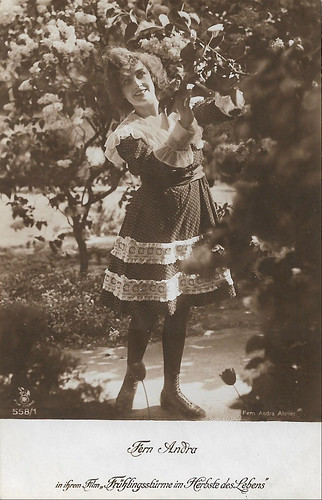
German postcard in the Film Sterne series by Rotophot, no. 558/1. Photo: Fern Andra Atelier. Fern Andra in Frühlingsstürme im Herbste des Lebens (Fern Andra, 1918).
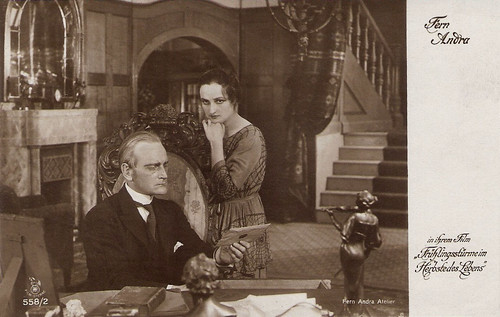
German postcard in the Film Sterne series by Rotophot, no. 558/2. Photo: Fern Andra Atelier. Fern Andra and Josef Peterhans in Frühlingsstürme im Herbste des Lebens (Fern Andra, 1918).
The only befitting alternative for a noblewoman
In Frühlingsstürme im Herbste des Lebens/Spring Storms in the Autumn of Life (Fern Andra, 1918) also translated as Spring Storms, Fern Andra plays the young Countess von Hagen. After the death of her father, she is taken in by his childhood friend Baron Joseph Königswart (Josef Peterhans).
The Baron lives with his cousin (Hella Tornegg) and her son Reinhold ( Reinhold Schünzel ) under one roof. Soon the young countess has both men falling for her. The advances of the young Reinhold she rejects, while Baron Joseph does not dare to confess his feelings for her because of his advanced age. And that, although the Countess reciprocates these same feelings.
Reinhold's mother is increasingly jealous because she is no longer playing the first fiddle in the house. Therefore, she accuses the young woman of theft. Deeply shaken by this monstrous accusation, the Countess sees only one alternative for her as a noblewoman befitting and proper way out: she wants to shoot herself - fittingly in the hunting lodge on the estate.
But the young lady is not aiming exactly and only wounds herself. Joseph hurries to her, declares his love, and becomes engaged to the Countess.
Frühlingsstürme im Herbste des Lebens/Spring Storms in the Autumn of Life was shot mid-1918 and offered to the German National Censorship Board in August 1918, after which it was forbidden for youngsters. The film had its premiere on 22 August 1918 at the Berlin cinema Marmorhaus.
In his weekly lexicon Paimann’s Filmlisten, Austrian Franz Paimann noted in 1918 about the film: "Story very good. Camera work and sets pretty good. Acting excellent." Kay Weniger added in Das grosse Personenlexikon des Films: "Andra's cinematic tearjerkers, set among the nobility or in the circus milieu, found a grateful audience during the First World War."
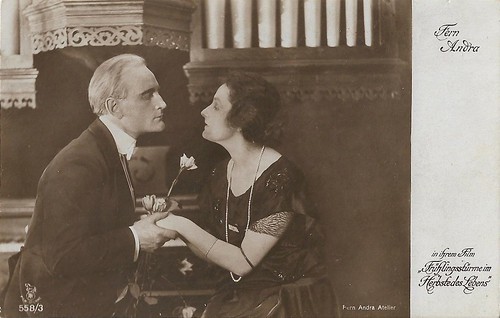
German postcard in the Film Sterne series by Rotophot, no. 558/3. Photo: Fern Andra Atelier. Fern Andra and Josef Peterhans in Frühlingsstürme im Herbste des Lebens (Fern Andra, 1918).
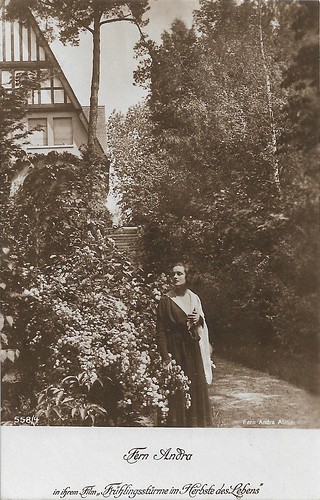
German postcard in the Film Sterne series by Rotophot, no. 558/4. Photo: Fern Andra Atelier. Fern Andra in Frühlingsstürme im Herbste des Lebens (Fern Andra, 1918).
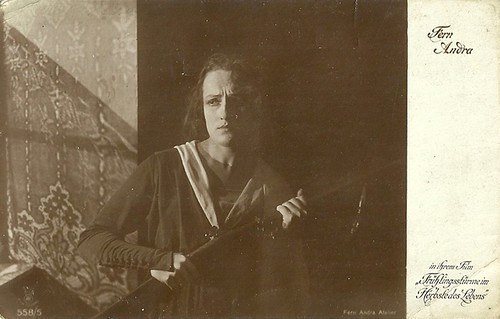
German postcard in the Film Sterne series by Rotophot, no. 558/5. Photo: Fern Andra Atelier. Fern Andra in Frühlingsstürme im Herbste des Lebens (Fern Andra, 1918).
Sources: Wikipedia (German and English) and IMDb.

German postcard in the Film Sterne series by Rotophot, no. 558/1. Photo: Fern Andra Atelier. Fern Andra in Frühlingsstürme im Herbste des Lebens (Fern Andra, 1918).

German postcard in the Film Sterne series by Rotophot, no. 558/2. Photo: Fern Andra Atelier. Fern Andra and Josef Peterhans in Frühlingsstürme im Herbste des Lebens (Fern Andra, 1918).
The only befitting alternative for a noblewoman
In Frühlingsstürme im Herbste des Lebens/Spring Storms in the Autumn of Life (Fern Andra, 1918) also translated as Spring Storms, Fern Andra plays the young Countess von Hagen. After the death of her father, she is taken in by his childhood friend Baron Joseph Königswart (Josef Peterhans).
The Baron lives with his cousin (Hella Tornegg) and her son Reinhold ( Reinhold Schünzel ) under one roof. Soon the young countess has both men falling for her. The advances of the young Reinhold she rejects, while Baron Joseph does not dare to confess his feelings for her because of his advanced age. And that, although the Countess reciprocates these same feelings.
Reinhold's mother is increasingly jealous because she is no longer playing the first fiddle in the house. Therefore, she accuses the young woman of theft. Deeply shaken by this monstrous accusation, the Countess sees only one alternative for her as a noblewoman befitting and proper way out: she wants to shoot herself - fittingly in the hunting lodge on the estate.
But the young lady is not aiming exactly and only wounds herself. Joseph hurries to her, declares his love, and becomes engaged to the Countess.
Frühlingsstürme im Herbste des Lebens/Spring Storms in the Autumn of Life was shot mid-1918 and offered to the German National Censorship Board in August 1918, after which it was forbidden for youngsters. The film had its premiere on 22 August 1918 at the Berlin cinema Marmorhaus.
In his weekly lexicon Paimann’s Filmlisten, Austrian Franz Paimann noted in 1918 about the film: "Story very good. Camera work and sets pretty good. Acting excellent." Kay Weniger added in Das grosse Personenlexikon des Films: "Andra's cinematic tearjerkers, set among the nobility or in the circus milieu, found a grateful audience during the First World War."

German postcard in the Film Sterne series by Rotophot, no. 558/3. Photo: Fern Andra Atelier. Fern Andra and Josef Peterhans in Frühlingsstürme im Herbste des Lebens (Fern Andra, 1918).

German postcard in the Film Sterne series by Rotophot, no. 558/4. Photo: Fern Andra Atelier. Fern Andra in Frühlingsstürme im Herbste des Lebens (Fern Andra, 1918).

German postcard in the Film Sterne series by Rotophot, no. 558/5. Photo: Fern Andra Atelier. Fern Andra in Frühlingsstürme im Herbste des Lebens (Fern Andra, 1918).
Sources: Wikipedia (German and English) and IMDb.
Published on July 22, 2019 22:00
July 21, 2019
Éva Ruttkay
Éva Ruttkay (1927-1986) was one of the greatest Hungarian actresses of the 20th Century. She appeared in more than 60 films and TV films in over six decades.
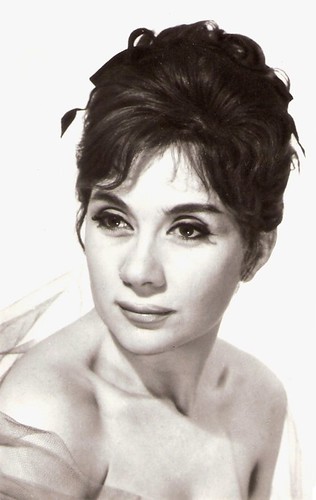
Czech collector's card by Pressfoto, Praha (Prague), no. 14/4, 1964. Retail price: 0,50 Kcs.

East-German postcard by VEB Progress Film-Vertrieb, Berlin, no. 2.570, 1966. Photo: Hungarofilm.
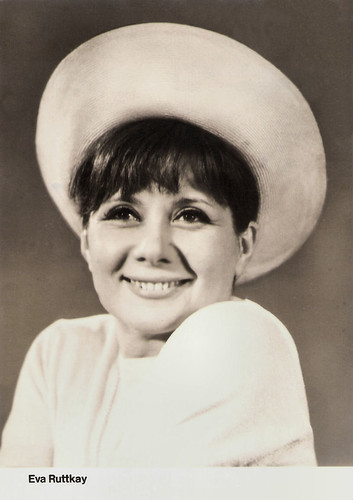
East-German postcard by VEB Progress Film-Vertrieb, Berlin, no. 2892, 1968. Photo: Hungarofilm.
The Hungarian Robin Hood
Éva Ruttkay (sometimes credited as Éva Ruttkai) was born as Éva Russ in Budapest, Hungary in 1927. As a child she already appeared in the film comedy Lila akác/Purple Lilacs (Steve Sekely, 1934) with Irén Biller .
At the age of 16, she gained the attention of Dániel Jób, director of the Vígszínház (Comedy Theatre), and she would play there until her death. An exception were the years 1948–1951, when she played at the Nemzeti Színházban (the National Theatre in Budapest).
During this period, she appeared in such film as Beszterce ostroma/The Siege of Beszterce (Márton Keleti, 1948), Szabóné (Félix Máriássy, 1949), and Lúdas Matyi/Mattie the Goose-boy (Kálmán Nádasdy, László Ranódy, 1950).
Lúdas Matyi was the first colour production from the newly nationalised Hungarian film industry. Inspired by Mihaly Fazekas' epic poem, the film stars Imre Soós as a Hungarian Robin Hood.
Éva Ruttkay fell in love with the well known actor Miklós Gábor, and they married in 1950. Two years later their daughter Julia was born.
In 1951 Éva already appeared on the Hungarian television, in the short TV comedy A Selejt bosszúja/The Revenge of Scrap (1951).
Some of her popular feature films of the 1950s were Liliomfi (Karoly Makk, 1954) again with Imre Soós , the comedy Egy pikoló világos/A Half Pint of Beer (Félix Máriássy, 1955), the drama Éjfélkor/Before Midnight (György Révész, 1957) with Miklós Gábor, Mese a 12 találatról/Tale of the 12 hit (Karoly Makk, 1956), Sóbálvány/Pillar of Salt (Zoltán Várkonyi, 1958) and Álmatlan évek/Sleepless Years (Félix Máriássy, 1959) with Mari Töröcsik .
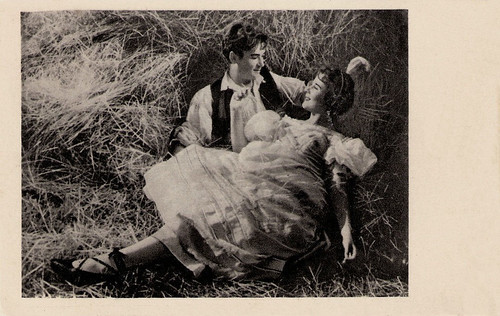
Hungarian postcard by Képzömüvészeti Alap Kiadóvállata, Budapest, no. 331/552. Photo: Saphir. Publicity still for Liliomfi (Károly Makk, 1954) with Imre Soós .
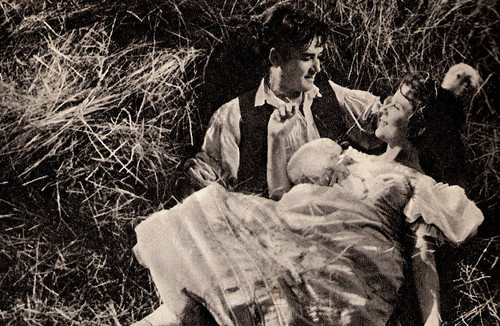
Hungarian postcard by Képzömüvészeti Alap Kiadóvállata, Budapest, no. 331/12/564. Photo: Saphir. Publicity still for Liliomfi (Károly Makk, 1954). Card price: 60 fillér.
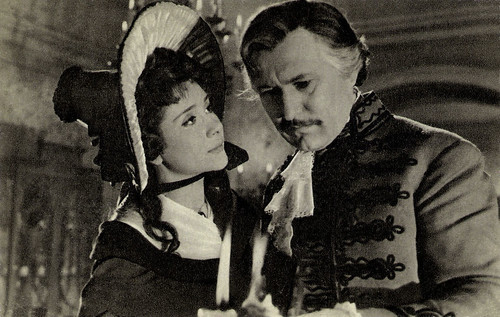
Hungarian postcard by Kepzömüvészeti Alap, Budapest, no. 331/24/564. Photo: Inkey. Publicity still for Kioltott lángok/Extinguished flames (Frigyes Bán, 1956) with Ferenc Bessenyei.
A Small Wonder
Éva Ruttkay continued her acting career successfully into the 1960s both on television and in such films as Három csillag/Three Stars (Miklós Jancsó, Zoltán Várkonyi, Karoly Wiedermann, 1960), Alázatosan jelentem/A Certain Major (Mihály Szemes, 1960), and the espionage action feature Fotó Háber/Haber's Photo Shop (Zoltán Várkonyi, 1963).
She also appeared in the classic comedy Butaságom története/Story of My Dumbness (Márton Keleti, 1965), Kárpáthy Zoltán (Zoltán Várkonyi, 1966), the comedy Tanulmány a nökröl/Study on Women (Márton Keleti, 1967), Egri csillagok/Stars of Eger (Zoltán Várkonyi, 1968), and Keresztelö/Baptism (István Gaál, 1968).
In the following decade she appeared in a.o. Utazás a koponyám körül/Trip Around My Cranium (Gyorgy Révész, 1970), Szindbád/Sinbad (Zoltan Huszarik, 1971), Labirintus/Labyrinth (András Kovács, 1976), Ha megjön József/When Joseph Returns (Zsolt Kézdi-Kovács, 1976), and several TV-series.
Among her last appearances were roles in the films Idö van/Time (Peter Gothar, 1986) and Küldetés Evianba/Mission to Evian (Erika Szántó, 1988).
In 1986, after thirty years the film Keseru Igazsag/The Bitter Truth (Zoltán Várkonyi, 1956-1986) was finally released. This 1956 film was banned in Hungary shortly after it was completed and just before the Soviet tanks rolled in to quell the Hungarian uprising. And small wonder - its ‘hero’ is a Party faithful whose corruption and lack of morality is disgusting, and its ‘antihero’ (played by Miklós Gábor) is someone honest and good, imprisoned for his anti-Party stance.
Her second husband was actor Zoltán Latinovits, whom she met in 1960 during rehearsals. They lived together until Latinovits's death. Half a year after her last stage appearance, Éva Ruttkay died in 1986 in her hometown Budapest. She was 58.
During her career she was awarded several times, with the Mari Jászai-award (in 1955 and 1959), the Kossuth-díj (1960), the ban Érdemes művész (1966), the ben Kiváló művész (1971), and the Pro Arte-díj. In 2006 the Éva Ruttkai Theatre opened its gates in Budapest.
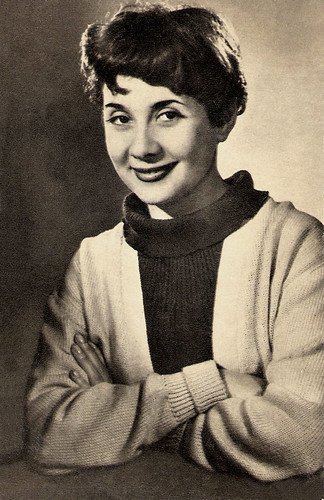
Hungarian postcard by Kepzömüvészeti Alap, Budapest, no. 5/583. Photo: Fény Szöv.
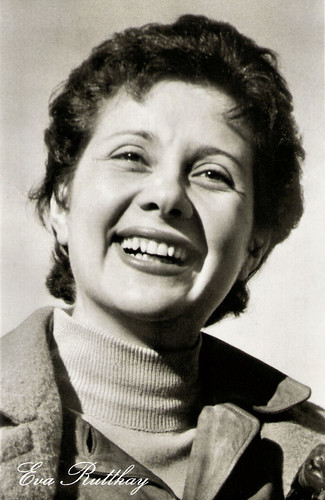
East-German postcard by Progress Starfoto, no. 927, 1958. Photo: Gerhard Kindt.
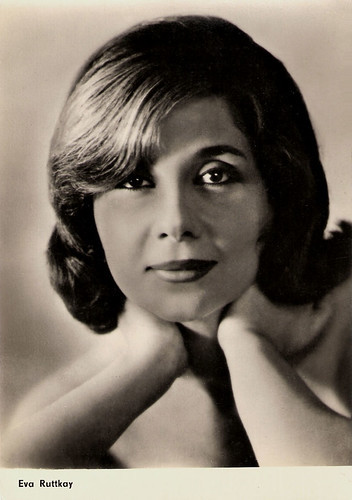
East-German postcard by VEB Progress Film-Vertrieb, Berlin, no. 1692, 1962. Retail price: 0,20 DM. Photo: Hungarofilm.

East-German postcard by VEB Progress Film-Vertrieb, Berlin, no. 1960, 1964. Retail price: 0,20 DM. Photo: Hungarofilm.
Sources: AllMovie, Wikipedia and .

Czech collector's card by Pressfoto, Praha (Prague), no. 14/4, 1964. Retail price: 0,50 Kcs.

East-German postcard by VEB Progress Film-Vertrieb, Berlin, no. 2.570, 1966. Photo: Hungarofilm.

East-German postcard by VEB Progress Film-Vertrieb, Berlin, no. 2892, 1968. Photo: Hungarofilm.
The Hungarian Robin Hood
Éva Ruttkay (sometimes credited as Éva Ruttkai) was born as Éva Russ in Budapest, Hungary in 1927. As a child she already appeared in the film comedy Lila akác/Purple Lilacs (Steve Sekely, 1934) with Irén Biller .
At the age of 16, she gained the attention of Dániel Jób, director of the Vígszínház (Comedy Theatre), and she would play there until her death. An exception were the years 1948–1951, when she played at the Nemzeti Színházban (the National Theatre in Budapest).
During this period, she appeared in such film as Beszterce ostroma/The Siege of Beszterce (Márton Keleti, 1948), Szabóné (Félix Máriássy, 1949), and Lúdas Matyi/Mattie the Goose-boy (Kálmán Nádasdy, László Ranódy, 1950).
Lúdas Matyi was the first colour production from the newly nationalised Hungarian film industry. Inspired by Mihaly Fazekas' epic poem, the film stars Imre Soós as a Hungarian Robin Hood.
Éva Ruttkay fell in love with the well known actor Miklós Gábor, and they married in 1950. Two years later their daughter Julia was born.
In 1951 Éva already appeared on the Hungarian television, in the short TV comedy A Selejt bosszúja/The Revenge of Scrap (1951).
Some of her popular feature films of the 1950s were Liliomfi (Karoly Makk, 1954) again with Imre Soós , the comedy Egy pikoló világos/A Half Pint of Beer (Félix Máriássy, 1955), the drama Éjfélkor/Before Midnight (György Révész, 1957) with Miklós Gábor, Mese a 12 találatról/Tale of the 12 hit (Karoly Makk, 1956), Sóbálvány/Pillar of Salt (Zoltán Várkonyi, 1958) and Álmatlan évek/Sleepless Years (Félix Máriássy, 1959) with Mari Töröcsik .

Hungarian postcard by Képzömüvészeti Alap Kiadóvállata, Budapest, no. 331/552. Photo: Saphir. Publicity still for Liliomfi (Károly Makk, 1954) with Imre Soós .

Hungarian postcard by Képzömüvészeti Alap Kiadóvállata, Budapest, no. 331/12/564. Photo: Saphir. Publicity still for Liliomfi (Károly Makk, 1954). Card price: 60 fillér.

Hungarian postcard by Kepzömüvészeti Alap, Budapest, no. 331/24/564. Photo: Inkey. Publicity still for Kioltott lángok/Extinguished flames (Frigyes Bán, 1956) with Ferenc Bessenyei.
A Small Wonder
Éva Ruttkay continued her acting career successfully into the 1960s both on television and in such films as Három csillag/Three Stars (Miklós Jancsó, Zoltán Várkonyi, Karoly Wiedermann, 1960), Alázatosan jelentem/A Certain Major (Mihály Szemes, 1960), and the espionage action feature Fotó Háber/Haber's Photo Shop (Zoltán Várkonyi, 1963).
She also appeared in the classic comedy Butaságom története/Story of My Dumbness (Márton Keleti, 1965), Kárpáthy Zoltán (Zoltán Várkonyi, 1966), the comedy Tanulmány a nökröl/Study on Women (Márton Keleti, 1967), Egri csillagok/Stars of Eger (Zoltán Várkonyi, 1968), and Keresztelö/Baptism (István Gaál, 1968).
In the following decade she appeared in a.o. Utazás a koponyám körül/Trip Around My Cranium (Gyorgy Révész, 1970), Szindbád/Sinbad (Zoltan Huszarik, 1971), Labirintus/Labyrinth (András Kovács, 1976), Ha megjön József/When Joseph Returns (Zsolt Kézdi-Kovács, 1976), and several TV-series.
Among her last appearances were roles in the films Idö van/Time (Peter Gothar, 1986) and Küldetés Evianba/Mission to Evian (Erika Szántó, 1988).
In 1986, after thirty years the film Keseru Igazsag/The Bitter Truth (Zoltán Várkonyi, 1956-1986) was finally released. This 1956 film was banned in Hungary shortly after it was completed and just before the Soviet tanks rolled in to quell the Hungarian uprising. And small wonder - its ‘hero’ is a Party faithful whose corruption and lack of morality is disgusting, and its ‘antihero’ (played by Miklós Gábor) is someone honest and good, imprisoned for his anti-Party stance.
Her second husband was actor Zoltán Latinovits, whom she met in 1960 during rehearsals. They lived together until Latinovits's death. Half a year after her last stage appearance, Éva Ruttkay died in 1986 in her hometown Budapest. She was 58.
During her career she was awarded several times, with the Mari Jászai-award (in 1955 and 1959), the Kossuth-díj (1960), the ban Érdemes művész (1966), the ben Kiváló művész (1971), and the Pro Arte-díj. In 2006 the Éva Ruttkai Theatre opened its gates in Budapest.

Hungarian postcard by Kepzömüvészeti Alap, Budapest, no. 5/583. Photo: Fény Szöv.

East-German postcard by Progress Starfoto, no. 927, 1958. Photo: Gerhard Kindt.

East-German postcard by VEB Progress Film-Vertrieb, Berlin, no. 1692, 1962. Retail price: 0,20 DM. Photo: Hungarofilm.

East-German postcard by VEB Progress Film-Vertrieb, Berlin, no. 1960, 1964. Retail price: 0,20 DM. Photo: Hungarofilm.
Sources: AllMovie, Wikipedia and .
Published on July 21, 2019 22:00
July 20, 2019
Jacqueline Logan
Jacqueline Logan (1901-1983) was a beautiful auburn-haired, green-eyed star of the silent screen. Her most famous part is Mary Magdalene in The King of Kings (1927) by Cecil B. DeMille.
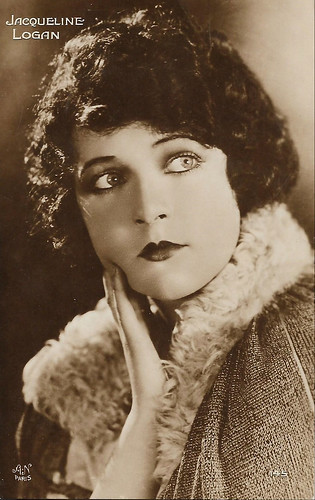
French postcard by Editions Cinémagazine / A.N., Paris, no. 145.
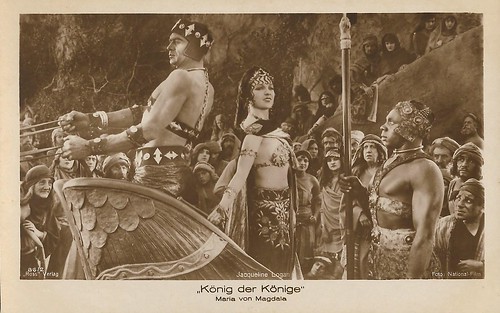
German postcard by Ross Verlag, no. 86/2. Photo: National Film. Postcard for the American silent epic The King of Kings (Cecil B. DeMille, 1927). Caption: Mary Magdalene. The charioteer was played by Noble Johnson, while Jacqueline Logan played Mary Magdalene.
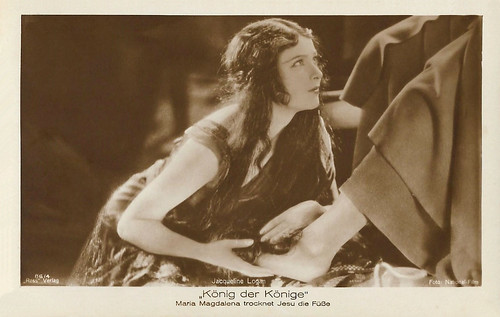
German postcard by Ross Verlag, no. 86/4. Photo: National Film. Jacqueline Logan in The King of Kings (Cecil B. deMille, 1927). Caption: Mary Magdalene dries Jesus' feet.
The beginning of a promising career
Jacqueline Medura Logan was born in Corsicana, Texas, in 1901 or 1904 (the sources differ). Her father, Charles A. Logan, was an architect and her mother, Marion Logan, was briefly an opera singer and later gave vocal lessons. Her childhood was spent in Scottsbluff, Nebraska where she briefly worked as a journalist for the Scottsbluff Republican.
After an aborted journalism study, 'Jackie' went to Chicago in the hope of success as an actress. There she had her first experiences as a dancer. Her family believed she intended to visit an uncle in the windy city and also to attend college. To get the dance job she had lied about her age, and when her uncle found out, he was irate. She was let go from the stage job as a result.
In 1920 she tried her luck in New York. She appeared in a revival of 'Florodora' on Broadway. Florenz Ziegfeld noticed her and hired her for a job dancing on his Ziegfeld Roof. She replaced Billie Donovan who was leaving to act in films in Hollywood. Together with the Ziegfeld venture, Logan modelled for noted Broadway photographer Alfred Cheney Johnston as a 'Dobbs Girl'. She also had a part in a Johnny Hines' comedy short.
Here Logan was discovered by director Allan Dwan, who cast her as the leading actress in his comedy drama A Perfect Crime (Alan Dwan, 1921). Logan was featured opposite Monte Blue and the young Jane Peters, the future Carole Lombard. The next years Logan was selected as WAMPAS Baby Star of 1922.
It was the beginning of a promising career. In the 1920s alone, Logan was in front of the camera in more than 50 silent films. Among her co-stars were Thomas Meighan, Milton Sills, Ricardo Cortez, Leatrice Joy, Richard Dix, Lon Chaney Sr. , and William Powell.
During the early 1920s, she appeared in such features as Burning Sands (George Melford, 1922), the horror film A Blind Bargain (Wallace Worsley, 1922), the comedy Sixty Cents an Hour (Joseph Henabery, 1923), the romantic drama Java Head (George Melford, 1923), and A Man Must Live (Paul Sloane, 1924).
The House of Youth (1924) was her first starring vehicle. In 1926, Logan made the comedy Footloose Widows (Roy Del Ruth, 1926) with Louise Fazenda, and the drama Blood Ship (George B. Seitz, 1927) with Hobart Bosworth and Richard Arlen.
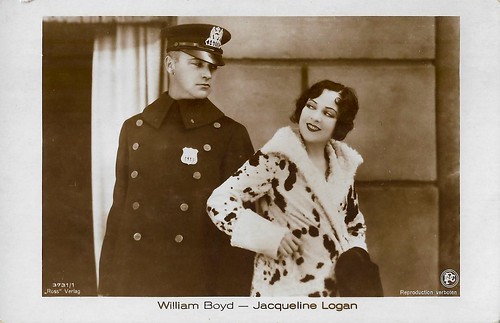
German postcard by Ross Verlag, no. 3731/1. Photo: DPG. Jacqueline Logan and William Boyd in The Cop (Donald Crisp, 1928).
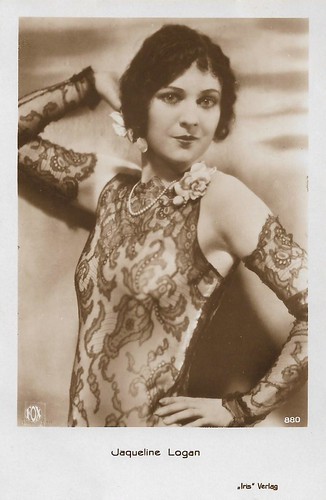
Austrian postcard by Iris Verlag, no. 880. Photo: Albert Witzel / Fox.
Cecil B. De Mille's Mary Magdalene
Jacqueline Logan's most famous film was the 1927-produced Bible film The King of the Kings by director Cecil B. DeMille, in which she acted as Mary Magdalene, a part sought after by many Hollywood actresses at the time. The film depicts the last weeks of Jesus before his crucifixion. Logan acted opposite H.B. Warner as Jesus, Victor Varconi as Pontius Pilate, and Dorothy Cumming as the Virgin Mary.
In 1929, she faced the change to sound film as a member of an all-star cast in the musical revue The Show of Shows by John G. Adolfi. The all talking Vitaphone production cost $850,000 and was shot almost entirely in Technicolor. Unaccountably, though she took vocal lessons, her career in talking pictures never took off.
Logan was in England for a time to do stage work such as 'Smoky Cell. This gained her some good reviews. After completing the English film Middle Watch (Norman Walker, 1930) with Owen Nares , British International Pictures signed her to write and direct. For BIP, she wrote Knock-Out (1931) and wrote and co-directed the 46-minute short film Strictly Business (Mary Field, Jacqueline Logan, 1931) starring Betty Amann .
She returned to Hollywood, but Columbia Pictures production chief Harry Cohn was complimentary of her work but unwilling to sign a female director. In the early 1930s, Logan got two roles in theatre productions, most recently between September 1934 and February 1935 in 'Merrily We Roll Along'.
Her private life was one of the reasons why her career came to a standstill. In 1934 she married the entrepreneur Larry Winston, for whom she gave up her career. However, the childless marriage ended up in in 1947.
More recently, Logan lived a life between New York and Florida and was involved in political affairs. She also became a member of the anti-Communist John Birch Society. In 1973, Logan appeared in the film comedy Naughty Wives one last time in front of the camera.
Jacqueline Logan died at the age of 81 in April 1983 in Melbourne, Florida, and was buried in Greenwood Cemetery in Decatur, Illinois.
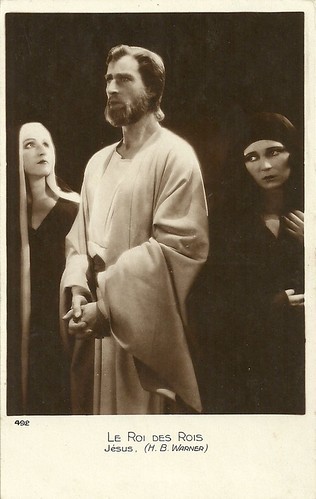
French postcard, no. 492. Postcard for the American silent epic The King of Kings (Cecil B. DeMille, 1927). Jesus (H.B. Warner) between the Virgin Mary (Dorothy Cumming) and Mary Magdalene (Jacqueline Logan).
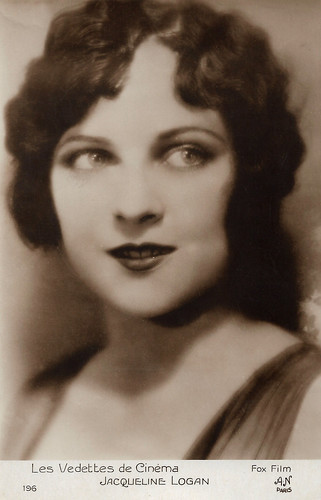
French postcard in the Les Vedettes de Cinéma series by A.N., Paris, no. 196. Photo: Fox Film.
Sources: (IMDb), Wikipedia (English and German), and .

French postcard by Editions Cinémagazine / A.N., Paris, no. 145.

German postcard by Ross Verlag, no. 86/2. Photo: National Film. Postcard for the American silent epic The King of Kings (Cecil B. DeMille, 1927). Caption: Mary Magdalene. The charioteer was played by Noble Johnson, while Jacqueline Logan played Mary Magdalene.

German postcard by Ross Verlag, no. 86/4. Photo: National Film. Jacqueline Logan in The King of Kings (Cecil B. deMille, 1927). Caption: Mary Magdalene dries Jesus' feet.
The beginning of a promising career
Jacqueline Medura Logan was born in Corsicana, Texas, in 1901 or 1904 (the sources differ). Her father, Charles A. Logan, was an architect and her mother, Marion Logan, was briefly an opera singer and later gave vocal lessons. Her childhood was spent in Scottsbluff, Nebraska where she briefly worked as a journalist for the Scottsbluff Republican.
After an aborted journalism study, 'Jackie' went to Chicago in the hope of success as an actress. There she had her first experiences as a dancer. Her family believed she intended to visit an uncle in the windy city and also to attend college. To get the dance job she had lied about her age, and when her uncle found out, he was irate. She was let go from the stage job as a result.
In 1920 she tried her luck in New York. She appeared in a revival of 'Florodora' on Broadway. Florenz Ziegfeld noticed her and hired her for a job dancing on his Ziegfeld Roof. She replaced Billie Donovan who was leaving to act in films in Hollywood. Together with the Ziegfeld venture, Logan modelled for noted Broadway photographer Alfred Cheney Johnston as a 'Dobbs Girl'. She also had a part in a Johnny Hines' comedy short.
Here Logan was discovered by director Allan Dwan, who cast her as the leading actress in his comedy drama A Perfect Crime (Alan Dwan, 1921). Logan was featured opposite Monte Blue and the young Jane Peters, the future Carole Lombard. The next years Logan was selected as WAMPAS Baby Star of 1922.
It was the beginning of a promising career. In the 1920s alone, Logan was in front of the camera in more than 50 silent films. Among her co-stars were Thomas Meighan, Milton Sills, Ricardo Cortez, Leatrice Joy, Richard Dix, Lon Chaney Sr. , and William Powell.
During the early 1920s, she appeared in such features as Burning Sands (George Melford, 1922), the horror film A Blind Bargain (Wallace Worsley, 1922), the comedy Sixty Cents an Hour (Joseph Henabery, 1923), the romantic drama Java Head (George Melford, 1923), and A Man Must Live (Paul Sloane, 1924).
The House of Youth (1924) was her first starring vehicle. In 1926, Logan made the comedy Footloose Widows (Roy Del Ruth, 1926) with Louise Fazenda, and the drama Blood Ship (George B. Seitz, 1927) with Hobart Bosworth and Richard Arlen.

German postcard by Ross Verlag, no. 3731/1. Photo: DPG. Jacqueline Logan and William Boyd in The Cop (Donald Crisp, 1928).

Austrian postcard by Iris Verlag, no. 880. Photo: Albert Witzel / Fox.
Cecil B. De Mille's Mary Magdalene
Jacqueline Logan's most famous film was the 1927-produced Bible film The King of the Kings by director Cecil B. DeMille, in which she acted as Mary Magdalene, a part sought after by many Hollywood actresses at the time. The film depicts the last weeks of Jesus before his crucifixion. Logan acted opposite H.B. Warner as Jesus, Victor Varconi as Pontius Pilate, and Dorothy Cumming as the Virgin Mary.
In 1929, she faced the change to sound film as a member of an all-star cast in the musical revue The Show of Shows by John G. Adolfi. The all talking Vitaphone production cost $850,000 and was shot almost entirely in Technicolor. Unaccountably, though she took vocal lessons, her career in talking pictures never took off.
Logan was in England for a time to do stage work such as 'Smoky Cell. This gained her some good reviews. After completing the English film Middle Watch (Norman Walker, 1930) with Owen Nares , British International Pictures signed her to write and direct. For BIP, she wrote Knock-Out (1931) and wrote and co-directed the 46-minute short film Strictly Business (Mary Field, Jacqueline Logan, 1931) starring Betty Amann .
She returned to Hollywood, but Columbia Pictures production chief Harry Cohn was complimentary of her work but unwilling to sign a female director. In the early 1930s, Logan got two roles in theatre productions, most recently between September 1934 and February 1935 in 'Merrily We Roll Along'.
Her private life was one of the reasons why her career came to a standstill. In 1934 she married the entrepreneur Larry Winston, for whom she gave up her career. However, the childless marriage ended up in in 1947.
More recently, Logan lived a life between New York and Florida and was involved in political affairs. She also became a member of the anti-Communist John Birch Society. In 1973, Logan appeared in the film comedy Naughty Wives one last time in front of the camera.
Jacqueline Logan died at the age of 81 in April 1983 in Melbourne, Florida, and was buried in Greenwood Cemetery in Decatur, Illinois.

French postcard, no. 492. Postcard for the American silent epic The King of Kings (Cecil B. DeMille, 1927). Jesus (H.B. Warner) between the Virgin Mary (Dorothy Cumming) and Mary Magdalene (Jacqueline Logan).

French postcard in the Les Vedettes de Cinéma series by A.N., Paris, no. 196. Photo: Fox Film.
Sources: (IMDb), Wikipedia (English and German), and .
Published on July 20, 2019 22:00
July 19, 2019
Angelo, Budapest, 1918
In 1918, the Hungarian silent cinema was at its best. An amazing amount of talent in Budapest was producing one film after another. Among them were the directors Alexander Korda and Michael Curtiz, and actors like Béla Lugosi, Vilma Bánky, Paul Lukas and Lya de Putti. Pál Funk was the major photographer of the film community. He worked under the name of Angelo and his glamorous film star portraits graced countless European postcards. Today EFSP presents a post with portraits he all made in Budapest in 1918. They were used for Hungarian postcards and for German postcards by the NPG (Neue Photografische Gesellschaft).
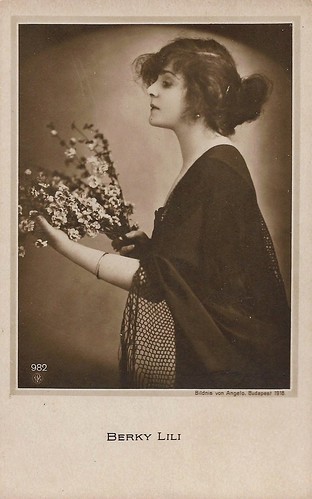
German postcard by NPG, no. 982. Photo: Angelo, Budapest, 1918.
Lili Berky (1886–1958), aka Lilli Berky and Lili Berki, was a Hungarian stage and screen actress, who starred in over 30 Hungarian silent films between 1913 and the late 1920s and played in an equal amount of Hungarian sound films, mainly in the 1930s and early 1940s. In 1917 she became the wife of Hungarian actor and comedian Gyula Gózon. They often performed together.
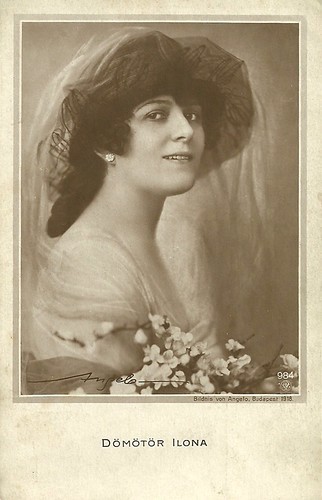
German postcard by NPG, no. 984. Photo: Angelo, Budapest, 1918.
Ilona Dömötör was a Hungarian stage actress. As far as known, she only acted in one silent film, A fogadalom/The vow (J. Béla Geröffy, 1921). Very little is known about her.
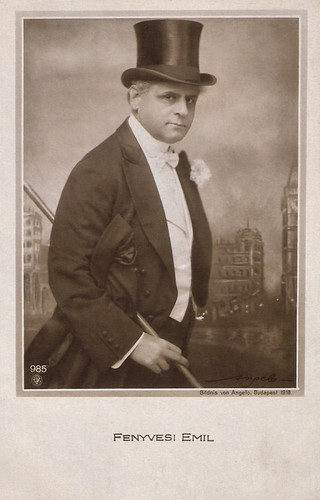
German postcard by NPG, no. 985. Photo: Angelo, Budapest, 1918.
Emil Fenyvesy (1859–1924) was a monstre sacré of the Hungarian stage, who also acted in some 23 Hungarian silent films between 1912 and 1923. He was in his fifties when he started as a screen actor. He first acted in four films by Sándor Góth: Víg özvegy (1912) with Ferenc Vendrey and Ica von Lenkeffy, A páter és a Péter (1912), again with Vendrey, A Marhakereskedö (1913), and A csikós (1913). Then he played a rabbi in Alexander Korda's Lyon Lea (1915). In 1917-1919 he peaked with 6 to 8 films per year, in Hungarian silent films by mainly Márton Garas. He was Karenin in Anna Karenina (1918), played opposite Leopoldine Konstantin and Dezsõ Kertész in A Táncosnö/The dancer (1919) and was Mr. Brownlow in Oliver Twist (1919). Other directors he worked with were Carl Wilhelm and Alexander Korda. In Tavaszi szerelem (1921) by a young Géza von Bolváry, Fenyvesy acted opposite Vilma Bánky and Norbert Dán. Fenyvesi's last film roles were as a rabbi and father of Ernö Verebes in Péntek este (Alfréd Deésy, 1921), an unknown part in Az egyhuszasos lány (Uwe Jens Krafft, 1923), and as Emperor Franz Joseph in Alexander Korda's Tragödie im Hause Habsburg (1924), a German production about the Mayerling Affair, with Maria Corda as Maria Vetsera, lover of Crown prince Rudolph (Kálmán Zátony). Emil Fenyvesy died in Budapest in 1924.
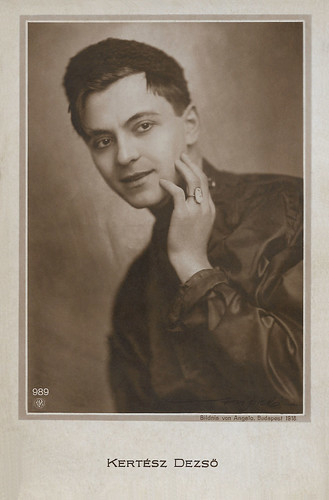
German postcard by NPG, no. 989. Photo: Angelo, Budapest, 1918.
Dezső Kertész (1890-1965) acted in some seven silent Hungarian films in the 1910s and returned to the set in the early sound era and the war years. Kertész debuted on screen as the Baron's son Laszlo in A Falu rossza/The Village Rogue (M. Miklós Pásztory, 1916), based on a play by Ede Tóth, and scripted by Ladislaus Vajda. He then played Absalon opposite Ica Lenkeffy in Szulamit (Jenö Illés, 1916), Dr. Gré in A Nevetö Szaszkia/The Laughing Saskia (Alexander Korda, 1916), A szentjóbi erdö titka/The Secret of St. Job Forest (Michael Curtiz, 1917), Három hét (Márton Garas, 1917) with Sári Fedák and based on Elinor Glyn's 'Three Weeks' about an unhappily married Queen (Fedak) who steps out for three weeks with a dashing count (Kertesz). Similarly, Kertesz played the rich bachelor Vronsky in Márton Garas' adaptation of Anna Karenina (1918), with Irén Varsányi in the title role. In 1919 Kertesz acted opposite Leopoldine Konstantin in A Táncosnö/The Dancer (Márton Garas, 1919), with Konstantin in the title role. All in all, Kertesz acted in some 18 silent Hungarian films until 1921.
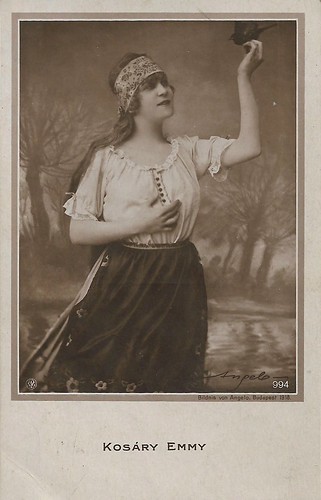
German postcard. NPG, no. 994. Photo Angelo, Budapest 1918.
Emmi Kosáry (1889-1964) was a Hungarian opera diva and operetta prima donna with a beautiful soprano voice. She also became a film actress, who worked in Hungary with the young Michael Curtiz. Kosáry was the wife of composer Ákos Buttykay.
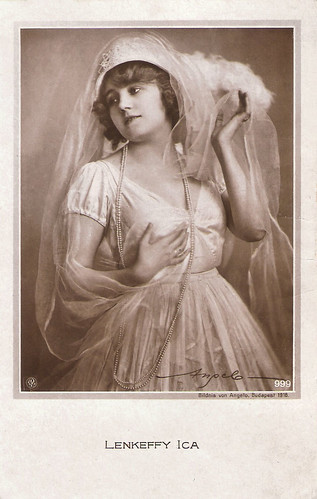
German postcard by NPG, no. 999. Photo: Angelo, Budapest, 1918.
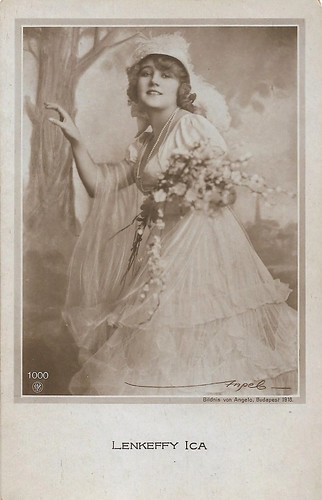
German postcard by NPG, no. 1000. Photo: Angelo, Budapest, 1918.
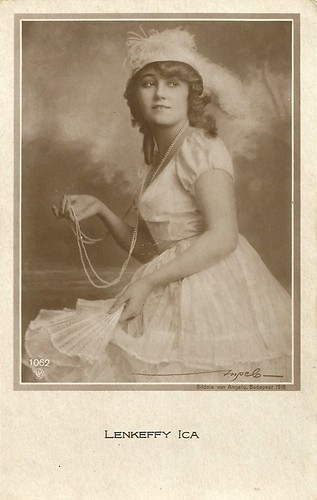
German postcard by NPG, no. 1062. Photo: Angelo, Budapest 1918.
Ica Lenkeffy aka Ica von Lenkeffy started in film in 1912 with director Sándor (Alexander) Góth, who had just started his career. Her first successful film was Szulamit (Jenő Illés, 1916), set in Old Testaments times and with Dezsõ Kertész as her co-star. Lenkeffy then mostly played in films directed by Márkus László, Bela Balogh, Mihály Kertész (Michael Curtiz) and Sándor (Alexander) Korda. Among her film partners were Alfréd Deésy, Oscar Beregi Sr., Gyula Csortos, Mihály Várkonyi (Victor Varconi), Iván Petrovich , and the later Oscar winner Pál Lukács (Paul Lukas). In 1921 Lenkeffy moved to Vienna and acted in Boccaccio (Michael Curtiz, 1920), also with Paul Lukas . She then moved on to Berlin, where she starred opposite Paul Hartmann in the May-Film production Die Erbin von Tordis (Robert Dinesen, 1921). In the German production of Othello (Dimitri Buchowetzki, 1922), Ica (by now Von) Lenkeffy played Desdemona opposite Emil Jannings as Othello and Werner Krauss as Jago. In 1923 Lenkeffy married Parisian banker Louis Mannheim. She moved to Paris with him, where she lived in luxury, but she retired from the film business at her husband's request.
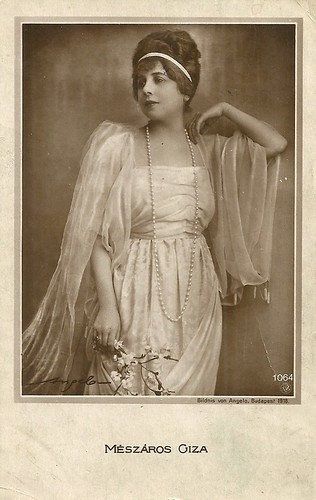
German postcard by NPG, no. 1064. Photo: Angelo, Budapest 1918.
Giza Mészáros (1879-1953) was a popular Hungarian stage actress, who also acted in some six silent Hungarian films of the 1910s. Her modest film career started with Egy csók története (Sándor Góth, 1912), which starred her partner Gyula Csortos. Afterward followed A Marhakereskedö (Sándor Góth, 1913), Lotti ezredesei/Colonel Lotti (Peter Paul Felner, 1916) in which she had the lead, A föld embere/Earth's Man (Michael Curtiz, 1917), starring Oscar Beregi as a mine engineer, and finally A hazugság/The Lie (Ödön Uher ifj., 1919), after Paul Bourget's novel 'Mensonges', about a woman with a double life as world-wise, frivolous lover of an older baron, and at the same time the chaste and remorseful lover of a young poet.

German postcard by NPG, no. 1065. Photo: Angelo, Budapest, 1918.
Ilonka [Ilona] Mezey or Mezei was a Hungarian actress, born 1892 in Budapest. She acted e.g. in Udvari levegö (Béla Balogh, 1919), starring Helene von Bolvary, and co-starring Jenö Törzs and Paul Lukas. Mezey also acted in A Kormánybiztos (Károly Lajthay, 1919).
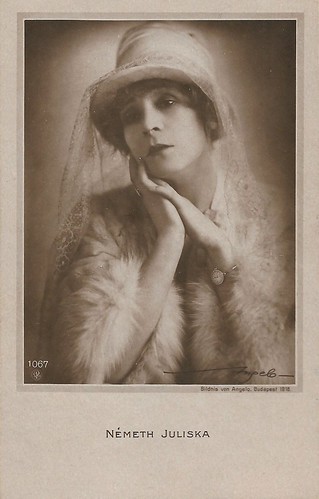
German postcard by NPG, no. 1067. Photo: Angelo, Budapest, 1918.
Juliska Németh (1890-1935) was a popular Hungarian cabaret performer in Hungary, Germany, and Austria, between the 1910s and the early 1930s. As far as known, she only acted in two Hungarian silent films: Júdás (Michael Curtiz, 1918), also with Gyula Gál and Claire Lotto, and Nantas (Béla Balogh, 1920), after Emile Zola's novel.
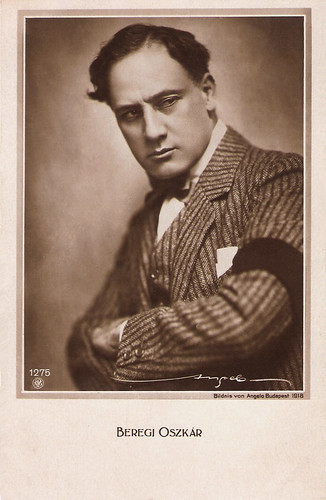
German postcard by NPG, no. 1275 Photo: Angelo, Budapest, 1918.
Hungarian stage and film actor Oscar Beregi, Sr. (1876-1965) appeared in 27 European and American films between 1916 and 1953. He is remembered as Dr. Baum in Fritz Lang’s Das Testament des Dr. Mabuse (1933).

German postcard by NPG, no. 1963. Photo Angelo, Budapest, 1918.
Ila Loth (1899-1975) was a Hungarian actress of the silent screen.
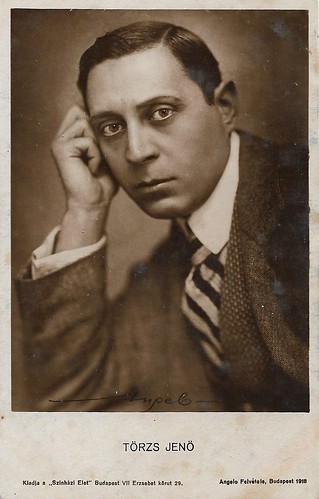
Hungarian postcard by Szinhazi Elet, Budapest. Photo: Angelo, Budapest, 1918.
Jenö Törzs (1887–1946) was a Hungarian stage and screen actor, who acted in over 20 Hungarian films in the 1910s, and returned to the screen in 10 more Hungarian films during the 1930s. Törzs was primarily a stage actor, playing great prose roles for many years on stage, often with Gyula Csortos as his antagonist. Törzs was able to keep his high quality on the film screen, appearing in some 20 early Hungarian silent films. He started in 1914 at Pathé Frères' Hungarian studio, in Sárga liliom (László Beöthy, Félix Vanyl, 1914), but it was really from 1917 onward, that he acted in 4 to 6 films a year between 1917 and 1921, such as A szentjóbi erdö titka (Michael Curtiz, 1917) with Dezsö Kertész, Vengerkák (Bela Balogh, 1917) with Ica Lenkeffy, Érdekházasság/Marriage interest (Antal Forgács, 1918) - an Elinor Glyn adaptation in which Törsz had the lead, Az isten fia és az ördög fia (Lajos Lázár, 1918) - again a lead, A csavargó/The tramp (Paul Sugar 1918) with Lya de Putti , Hivatalnok urak/Officers and gentlemen (Béla Balogh, 1919) - again, a lead - and Olivér Twist (Márton Garas, 1919) with László Z. Molnár as Fagin.
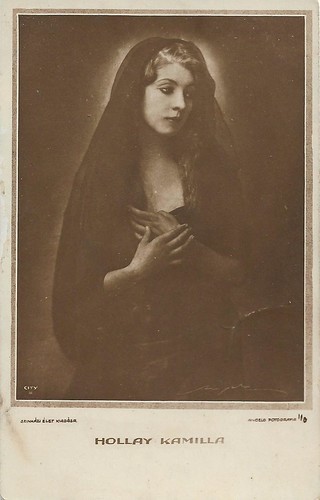
Hungarian postcard by Shinhazi Elet, Budapest, no. 111. Photo: Angelo, Budapest, 1918.
Camilla von Hollay (Kamilla Hollay) (1899–1967) was a Hungarian film actress of the silent era. She appeared in more than 40 films between 1916 and 1930.
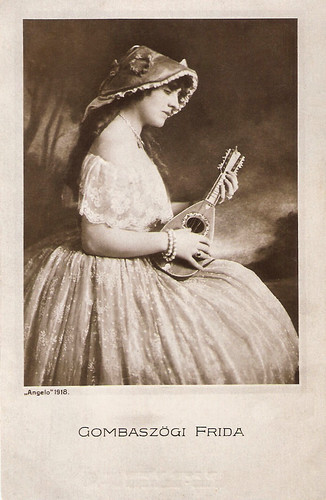
Hungarian postcard by Reinitz Jòzsef, Budapest / Terjeszti Gonda Oszkàr, Budapest. Photo: Angelo, 1918.
During her long and impressive career, Hungarian stage actress Frida Gombaszögi (1890–1961) appeared only in two, silent films. She was the first Hungarian actress who represented the modern acting style in plays by Molnar, Chekhov and Gorky.
Sources: Wikipedia (Hungarian) and .

German postcard by NPG, no. 982. Photo: Angelo, Budapest, 1918.
Lili Berky (1886–1958), aka Lilli Berky and Lili Berki, was a Hungarian stage and screen actress, who starred in over 30 Hungarian silent films between 1913 and the late 1920s and played in an equal amount of Hungarian sound films, mainly in the 1930s and early 1940s. In 1917 she became the wife of Hungarian actor and comedian Gyula Gózon. They often performed together.

German postcard by NPG, no. 984. Photo: Angelo, Budapest, 1918.
Ilona Dömötör was a Hungarian stage actress. As far as known, she only acted in one silent film, A fogadalom/The vow (J. Béla Geröffy, 1921). Very little is known about her.

German postcard by NPG, no. 985. Photo: Angelo, Budapest, 1918.
Emil Fenyvesy (1859–1924) was a monstre sacré of the Hungarian stage, who also acted in some 23 Hungarian silent films between 1912 and 1923. He was in his fifties when he started as a screen actor. He first acted in four films by Sándor Góth: Víg özvegy (1912) with Ferenc Vendrey and Ica von Lenkeffy, A páter és a Péter (1912), again with Vendrey, A Marhakereskedö (1913), and A csikós (1913). Then he played a rabbi in Alexander Korda's Lyon Lea (1915). In 1917-1919 he peaked with 6 to 8 films per year, in Hungarian silent films by mainly Márton Garas. He was Karenin in Anna Karenina (1918), played opposite Leopoldine Konstantin and Dezsõ Kertész in A Táncosnö/The dancer (1919) and was Mr. Brownlow in Oliver Twist (1919). Other directors he worked with were Carl Wilhelm and Alexander Korda. In Tavaszi szerelem (1921) by a young Géza von Bolváry, Fenyvesy acted opposite Vilma Bánky and Norbert Dán. Fenyvesi's last film roles were as a rabbi and father of Ernö Verebes in Péntek este (Alfréd Deésy, 1921), an unknown part in Az egyhuszasos lány (Uwe Jens Krafft, 1923), and as Emperor Franz Joseph in Alexander Korda's Tragödie im Hause Habsburg (1924), a German production about the Mayerling Affair, with Maria Corda as Maria Vetsera, lover of Crown prince Rudolph (Kálmán Zátony). Emil Fenyvesy died in Budapest in 1924.

German postcard by NPG, no. 989. Photo: Angelo, Budapest, 1918.
Dezső Kertész (1890-1965) acted in some seven silent Hungarian films in the 1910s and returned to the set in the early sound era and the war years. Kertész debuted on screen as the Baron's son Laszlo in A Falu rossza/The Village Rogue (M. Miklós Pásztory, 1916), based on a play by Ede Tóth, and scripted by Ladislaus Vajda. He then played Absalon opposite Ica Lenkeffy in Szulamit (Jenö Illés, 1916), Dr. Gré in A Nevetö Szaszkia/The Laughing Saskia (Alexander Korda, 1916), A szentjóbi erdö titka/The Secret of St. Job Forest (Michael Curtiz, 1917), Három hét (Márton Garas, 1917) with Sári Fedák and based on Elinor Glyn's 'Three Weeks' about an unhappily married Queen (Fedak) who steps out for three weeks with a dashing count (Kertesz). Similarly, Kertesz played the rich bachelor Vronsky in Márton Garas' adaptation of Anna Karenina (1918), with Irén Varsányi in the title role. In 1919 Kertesz acted opposite Leopoldine Konstantin in A Táncosnö/The Dancer (Márton Garas, 1919), with Konstantin in the title role. All in all, Kertesz acted in some 18 silent Hungarian films until 1921.

German postcard. NPG, no. 994. Photo Angelo, Budapest 1918.
Emmi Kosáry (1889-1964) was a Hungarian opera diva and operetta prima donna with a beautiful soprano voice. She also became a film actress, who worked in Hungary with the young Michael Curtiz. Kosáry was the wife of composer Ákos Buttykay.

German postcard by NPG, no. 999. Photo: Angelo, Budapest, 1918.

German postcard by NPG, no. 1000. Photo: Angelo, Budapest, 1918.

German postcard by NPG, no. 1062. Photo: Angelo, Budapest 1918.
Ica Lenkeffy aka Ica von Lenkeffy started in film in 1912 with director Sándor (Alexander) Góth, who had just started his career. Her first successful film was Szulamit (Jenő Illés, 1916), set in Old Testaments times and with Dezsõ Kertész as her co-star. Lenkeffy then mostly played in films directed by Márkus László, Bela Balogh, Mihály Kertész (Michael Curtiz) and Sándor (Alexander) Korda. Among her film partners were Alfréd Deésy, Oscar Beregi Sr., Gyula Csortos, Mihály Várkonyi (Victor Varconi), Iván Petrovich , and the later Oscar winner Pál Lukács (Paul Lukas). In 1921 Lenkeffy moved to Vienna and acted in Boccaccio (Michael Curtiz, 1920), also with Paul Lukas . She then moved on to Berlin, where she starred opposite Paul Hartmann in the May-Film production Die Erbin von Tordis (Robert Dinesen, 1921). In the German production of Othello (Dimitri Buchowetzki, 1922), Ica (by now Von) Lenkeffy played Desdemona opposite Emil Jannings as Othello and Werner Krauss as Jago. In 1923 Lenkeffy married Parisian banker Louis Mannheim. She moved to Paris with him, where she lived in luxury, but she retired from the film business at her husband's request.

German postcard by NPG, no. 1064. Photo: Angelo, Budapest 1918.
Giza Mészáros (1879-1953) was a popular Hungarian stage actress, who also acted in some six silent Hungarian films of the 1910s. Her modest film career started with Egy csók története (Sándor Góth, 1912), which starred her partner Gyula Csortos. Afterward followed A Marhakereskedö (Sándor Góth, 1913), Lotti ezredesei/Colonel Lotti (Peter Paul Felner, 1916) in which she had the lead, A föld embere/Earth's Man (Michael Curtiz, 1917), starring Oscar Beregi as a mine engineer, and finally A hazugság/The Lie (Ödön Uher ifj., 1919), after Paul Bourget's novel 'Mensonges', about a woman with a double life as world-wise, frivolous lover of an older baron, and at the same time the chaste and remorseful lover of a young poet.

German postcard by NPG, no. 1065. Photo: Angelo, Budapest, 1918.
Ilonka [Ilona] Mezey or Mezei was a Hungarian actress, born 1892 in Budapest. She acted e.g. in Udvari levegö (Béla Balogh, 1919), starring Helene von Bolvary, and co-starring Jenö Törzs and Paul Lukas. Mezey also acted in A Kormánybiztos (Károly Lajthay, 1919).

German postcard by NPG, no. 1067. Photo: Angelo, Budapest, 1918.
Juliska Németh (1890-1935) was a popular Hungarian cabaret performer in Hungary, Germany, and Austria, between the 1910s and the early 1930s. As far as known, she only acted in two Hungarian silent films: Júdás (Michael Curtiz, 1918), also with Gyula Gál and Claire Lotto, and Nantas (Béla Balogh, 1920), after Emile Zola's novel.

German postcard by NPG, no. 1275 Photo: Angelo, Budapest, 1918.
Hungarian stage and film actor Oscar Beregi, Sr. (1876-1965) appeared in 27 European and American films between 1916 and 1953. He is remembered as Dr. Baum in Fritz Lang’s Das Testament des Dr. Mabuse (1933).

German postcard by NPG, no. 1963. Photo Angelo, Budapest, 1918.
Ila Loth (1899-1975) was a Hungarian actress of the silent screen.

Hungarian postcard by Szinhazi Elet, Budapest. Photo: Angelo, Budapest, 1918.
Jenö Törzs (1887–1946) was a Hungarian stage and screen actor, who acted in over 20 Hungarian films in the 1910s, and returned to the screen in 10 more Hungarian films during the 1930s. Törzs was primarily a stage actor, playing great prose roles for many years on stage, often with Gyula Csortos as his antagonist. Törzs was able to keep his high quality on the film screen, appearing in some 20 early Hungarian silent films. He started in 1914 at Pathé Frères' Hungarian studio, in Sárga liliom (László Beöthy, Félix Vanyl, 1914), but it was really from 1917 onward, that he acted in 4 to 6 films a year between 1917 and 1921, such as A szentjóbi erdö titka (Michael Curtiz, 1917) with Dezsö Kertész, Vengerkák (Bela Balogh, 1917) with Ica Lenkeffy, Érdekházasság/Marriage interest (Antal Forgács, 1918) - an Elinor Glyn adaptation in which Törsz had the lead, Az isten fia és az ördög fia (Lajos Lázár, 1918) - again a lead, A csavargó/The tramp (Paul Sugar 1918) with Lya de Putti , Hivatalnok urak/Officers and gentlemen (Béla Balogh, 1919) - again, a lead - and Olivér Twist (Márton Garas, 1919) with László Z. Molnár as Fagin.

Hungarian postcard by Shinhazi Elet, Budapest, no. 111. Photo: Angelo, Budapest, 1918.
Camilla von Hollay (Kamilla Hollay) (1899–1967) was a Hungarian film actress of the silent era. She appeared in more than 40 films between 1916 and 1930.

Hungarian postcard by Reinitz Jòzsef, Budapest / Terjeszti Gonda Oszkàr, Budapest. Photo: Angelo, 1918.
During her long and impressive career, Hungarian stage actress Frida Gombaszögi (1890–1961) appeared only in two, silent films. She was the first Hungarian actress who represented the modern acting style in plays by Molnar, Chekhov and Gorky.
Sources: Wikipedia (Hungarian) and .
Published on July 19, 2019 22:00
July 18, 2019
Jodie Foster
American actress, director, and producer Jodie Foster (1962) has received two Academy Awards, three British Academy Film Awards, two Golden Globe Awards, a Screen Actors Guild Award and the Cecil B DeMille Award. A child prodigy, Foster began her professional career at the age of 3. Foster's breakthrough came at 14 with Martin Scorsese's psychological thriller Taxi Driver (1976). She played a child prostitute, for which she received an Oscar nomination. As an adult she won new acclaim with The Accused (1988), The Silence of the Lambs (1991), and Nell (1994). She later starred in four thrillers, Panic Room (2002), Flightplan (2005), Inside Man (2006) and The Brave One (2007), which were commercially successful and well-received by critics. She has focused on directing in the 2010s.
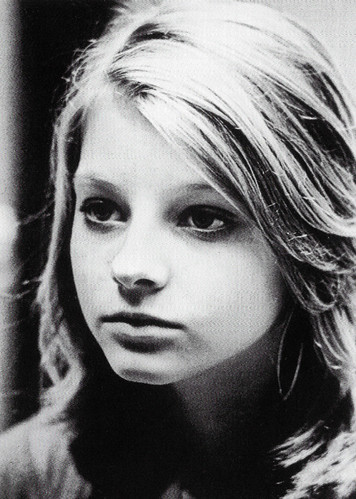
British postcard by Music & Movie Stars Ltd. Publishers, no. MMS 036. Jodie Foster in Taxi Driver (Martin Scorsese, 1976).
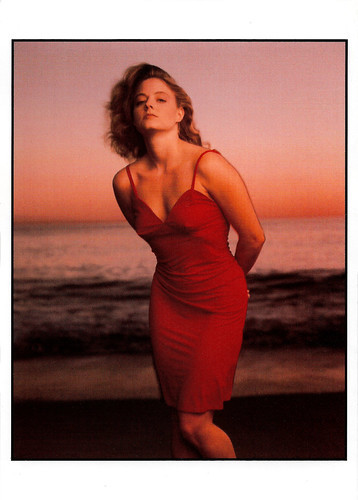
American postcard by Fotofolio, no. Z325. Photo: Annie Leibovitz. Caption: Jodie Foster, Malibu, California, 1988. Proceeds from the sale of this card donated to AIDS organizations.
A prostitute at the tender age of 12
Jodie Foster was born Alicia Christian Foster in 1962 in Los Angeles. She is the daughter of Evelyn Ella 'Brandy' (Almond), a producer, and Lucius Fisher Foster III, an Air Force lieutenant colonel and real estate broker. She is the younger sister of Buddy Foster, Cindy Foster Jones and Connie Foster, who all also acted. Brandy had filed for divorce in 1959 after having three children with Lucius, but the exes had a brief re-encounter in 1962 which resulted in Alicia's birth.
Her older siblings nicknamed her Jodie, a name she has used in her profession. She started her career in a Coppertone Suntan Lotion commercial when she was 3 years old and made commercials for four years. She made her debut as an actress in the TV series Mayberry R.F.D. (1968), on which her brother, Buddy Foster, was a regular. She stayed very busy as a child actress, working on television programs such as The Doris Day Show (1968), Adam-12 (1968), The Courtship of Eddie's Father (1969), The Partridge Family (1970), Bonanza (1972), and Gunsmoke (1969-1972).
After her film debut in Disney's Napoleon and Samantha (Bernard McEveety, 1972), Foster was much in demand. Her film roles included playing Raquel Welch 's daughter in Kansas City Bomber (Jerold Freedman, 1972) and a tomboy in Alice Doesn't Live Here Anymore (Martin Scorsese, 1974) starring Ellen Burstyn. She starred as Addie Pray on the short-lived television series Paper Moon (1974), which was originally a film by Peter Bogdanovich starring Tatum O'Neal.
Jodie first drew attention from critics with her appearance in Martin Scorsese's Taxi Driver (1976) alongside Robert De Niro and Harvey Keitel, where she played a prostitute at the tender age of 12. Her sister, Connie Foster, was her stand-in during the more explicit scenes. She received her first Oscar nomination as Best Supporting Actress for her role.
She was 12 turning 13 during production of The Little Girl Who Lives Down the Lane (Nicolas Gessner, 1976), for which she won the Saturn Award for Best Actress. Foster went on to have a very successful career in her early teens with leading roles in Bugsy Malone (Alan Parker, 1976) as the mini-vamp Tallulah, and the Disney films Freaky Friday (Gary Nelson, 1976) with Barbara Harris, and Candleshoe (Norman Tokar, 1977) opposite David Niven and Helen Hayes.
Fluent in French by age 14, she spoke her own lines in the French film Moi, fleur bleue (Eric Le Hung, 1977) with Jean Yanne and Sydne Rome . She also co-starred in the Italian comedy Casotto (Sergio Citti, 1977) with Catherine Deneuve . The last film she made during this era was the coming-of-age drama Foxes (Adrian Lyne, 1980), before enrolling at Yale University.
In 1981, during her freshman year at Yale, she was attached to a worldwide scandal when a crazed and obsessed fan named John Hinckley stalked her and attempted to assassinate President Reagan. When captured, Hinckley insisted he'd done it to impress Foster - a re-creation of a similar incident in Taxi Driver.
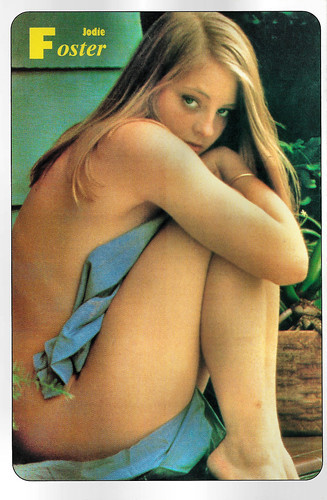
Italian postcard in the Le più belle del mondo series by Tele Tutto, no. 11.
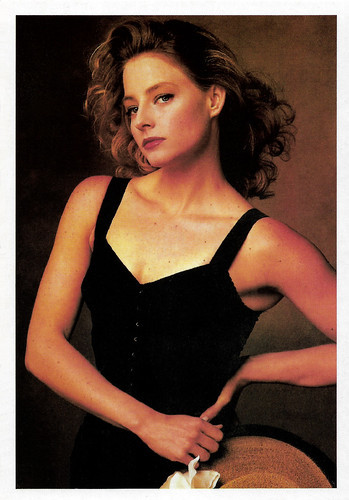
Postcard, no. 135.
A waitress who is gang-raped in a bar
In 1985, Jodie Foster graduated magna cum laude from Yale University with a degree in literature. She resumed her acting career and appeared in the comedy drama The Hotel New Hampshire (Tony Richardson, 1984) opposite Rob Lowe and Nastassia Kinski , and based on the novel by John Irving. In France, she appeared in the historical drama Le sang des autres/The Blood of Others (Claude Chabrol, 1984) based on the novel by Simone de Beauvoir.
Foster sought a breakthrough role that would return her to stardom. After appearing in a few obscure films with limited release, she landed an audition for The Accused (Jonathan Kaplan, 1988). She was cast in the part of Sarah Tobias, a waitress who is gang-raped in a bar during a night of partying and teams up with a lawyer played by Kelly McGillis to prosecute the attackers. This performance earned her an Academy Award for Best Actress, but despite the Oscar win, Jodie still hadn't re-established herself as a bankable star.
Her next film, Catchfire (Dennis Hopper, 1990), went straight to video, and she had to campaign hard to get her next good role. In 1991, she starred as Clarice Starling, an FBI trainee assisting in a hunt for a serial killer in The Silence of the Lambs (Jonathan Demme, 1991) with Anthony Hopkins. The film was a blockbuster hit, winning Jodie her second Academy Award for Best Actress and establishing her as an international film star.
With the wealth and fame to do anything she wanted, Jodie started directing. She made her directorial debut with Little Man Tate (Jodie Foster, 1991), about the tribulations of a child genius. It was followed by Home for the Holidays (Jodie Foster, 1995) with Holly Hunter, Anne Bancroft and Robert Downey Jr. These films were critically acclaimed but did not do well at the box office, and she proved to be a far more successful actress than she was a director.
On the set of Sommersby (Jon Amiel, 1993) with Richard Gere , she met Cydney Bernard and was in a serious relationship with her until they broke up in 2008. 1994 was a huge triumph for her acting career. She first played a sexy con artist in the successful Western comedy Maverick (Richard Donner, 1994) with Mel Gibson and James Garner.
She made her debut as producer in 1994 with Nell (Michael Apted, 1994). She also played the title role opposite Liam Neeson and Natasha Richardson. For her compelling performance as a wild, backwoods hermit who speaks an invented language and must return to civilisation, Jodie was nominated for another Academy Award and won a Screen Actors Guild Award as Best Actress.
Although she was working far less frequently as an adult than she did as a child, the films she turned out were commercially successful and critically acclaimed. Her next big screen role was in the science fiction drama Contact (Robert Zemeckis, 1997) opposite Matthew McConaughey. She played a scientist who receives signals from space aliens. The film was a huge hit and brought her a Golden Globe nomination.
She had to pull out of Double Jeopardy (Bruce Beresford, 1999) because she became pregnant, and was replaced by Ashley Judd. In 1999, her son Charles Foster, with partner Cydney Bernard, was born. She returned to work four months later in order to begin filming Anna and the King (Andy Tennant, 1999), a non-musical remake of The King and I (Walter Lang, 1956). The film was only modestly received in the U.S. but was successful in the rest of the world.
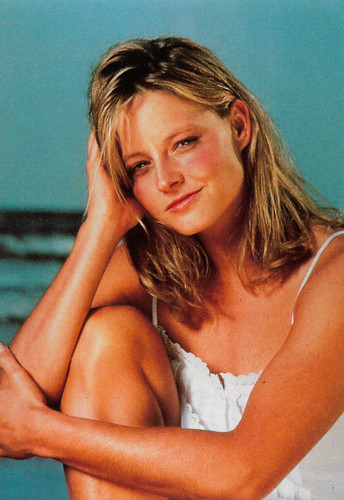
British postcard by Heroes Publishing Ltd., London, no. SPC2540.
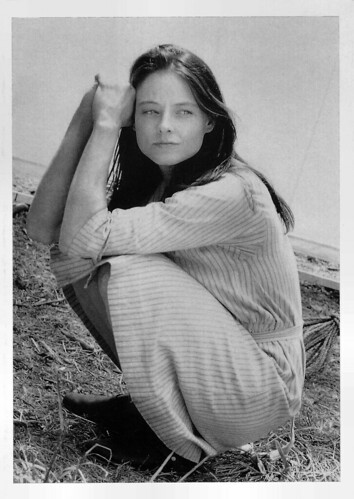
Canadian postcard by Canadian Postcard, no. A-253. Jodie Foster in Nell (Michael Apted, 1994).
Playing tough women in mainstream thrillers
Jodie Foster returned to work four months after giving birth to her second son Kit Foster, but she shut down her production company Egg Pictures in late 2001 to spend more time with her children. She headlined the thriller Panic Room (David Fincher, 2002), which co-starred Kristen Stewart. The film was a smash box-office hit and gave Jodie a $30 million opening weekend, the biggest of her career yet.
She then appeared in two low-profile projects: the independent film The Dangerous Lives of Altar Boys (Peter Care, 2002) and the French film Un long dimanche de fiançailles (Jean-Pierre Jeunet, 2004) with Audrey Tautou and Gaspard Ulliel.
She returned to making Hollywood mainstream films, first with Flightplan (Robert Schwentke, 2005), in which she played a woman whose daughter disappears on an airplane that she designed. Once again Jodie proved herself to be a box-office draw, and the film was a worldwide hit.
The following year, she starred in another hit, the bank heist thriller Inside Man (Spike Lee, 2006) with Denzel Washington and Clive Owen. Jodie was on a roll. Her next film was the revenge thriller The Brave One (Neil Jordan, 2007), which once again opened at #1 at the box office and earned her another Golden Globe nomination for Best Actress.
Following this succession of thrillers that all had her playing tough women, Jodie returned to the comedy genre in Nim's Island (Jennifer Flackett, Mark Levin, 2008) with Gerard Butler and Abigail Breslin. She reunited with Mel Gibson in the comedy The Beaver (Jodie Foster, 2011). Strong roles followed in Carnage (Roman Polanski, 2011) with Kate Winslet , and the Sci-Fi film Elysium (Neill Blomkamp, 2013) with Matt Damon.
In 2013, she received the Cecil B. DeMille award at the Golden Globe Awards. In April 2016, Jodie Foster married Alexandra Hedison. In July that year, John Hinckley was released after almost 35 years of commission to St. Elizabeth's Mental Institution. Lately, she focused on directing and made the film Money Monster (2016), as well as episodes for the TV series Orange Is the New Black, House of Cards, and Black Mirror.
Jodie Foster's most recent film is Hotel Artemis (Drew Pearce, 2018) in which she runs a high-security, members-only hospital for high-rolling criminals in Los Angeles.
Trailer Taxi Driver (1976). Source: YouTube Movies (YouTube).
Trailer Hotel Artemis (2018). Source: Zero Media (YouTube).
Sources: Hal Erickson (AllMovie), Wikipedia and .

British postcard by Music & Movie Stars Ltd. Publishers, no. MMS 036. Jodie Foster in Taxi Driver (Martin Scorsese, 1976).

American postcard by Fotofolio, no. Z325. Photo: Annie Leibovitz. Caption: Jodie Foster, Malibu, California, 1988. Proceeds from the sale of this card donated to AIDS organizations.
A prostitute at the tender age of 12
Jodie Foster was born Alicia Christian Foster in 1962 in Los Angeles. She is the daughter of Evelyn Ella 'Brandy' (Almond), a producer, and Lucius Fisher Foster III, an Air Force lieutenant colonel and real estate broker. She is the younger sister of Buddy Foster, Cindy Foster Jones and Connie Foster, who all also acted. Brandy had filed for divorce in 1959 after having three children with Lucius, but the exes had a brief re-encounter in 1962 which resulted in Alicia's birth.
Her older siblings nicknamed her Jodie, a name she has used in her profession. She started her career in a Coppertone Suntan Lotion commercial when she was 3 years old and made commercials for four years. She made her debut as an actress in the TV series Mayberry R.F.D. (1968), on which her brother, Buddy Foster, was a regular. She stayed very busy as a child actress, working on television programs such as The Doris Day Show (1968), Adam-12 (1968), The Courtship of Eddie's Father (1969), The Partridge Family (1970), Bonanza (1972), and Gunsmoke (1969-1972).
After her film debut in Disney's Napoleon and Samantha (Bernard McEveety, 1972), Foster was much in demand. Her film roles included playing Raquel Welch 's daughter in Kansas City Bomber (Jerold Freedman, 1972) and a tomboy in Alice Doesn't Live Here Anymore (Martin Scorsese, 1974) starring Ellen Burstyn. She starred as Addie Pray on the short-lived television series Paper Moon (1974), which was originally a film by Peter Bogdanovich starring Tatum O'Neal.
Jodie first drew attention from critics with her appearance in Martin Scorsese's Taxi Driver (1976) alongside Robert De Niro and Harvey Keitel, where she played a prostitute at the tender age of 12. Her sister, Connie Foster, was her stand-in during the more explicit scenes. She received her first Oscar nomination as Best Supporting Actress for her role.
She was 12 turning 13 during production of The Little Girl Who Lives Down the Lane (Nicolas Gessner, 1976), for which she won the Saturn Award for Best Actress. Foster went on to have a very successful career in her early teens with leading roles in Bugsy Malone (Alan Parker, 1976) as the mini-vamp Tallulah, and the Disney films Freaky Friday (Gary Nelson, 1976) with Barbara Harris, and Candleshoe (Norman Tokar, 1977) opposite David Niven and Helen Hayes.
Fluent in French by age 14, she spoke her own lines in the French film Moi, fleur bleue (Eric Le Hung, 1977) with Jean Yanne and Sydne Rome . She also co-starred in the Italian comedy Casotto (Sergio Citti, 1977) with Catherine Deneuve . The last film she made during this era was the coming-of-age drama Foxes (Adrian Lyne, 1980), before enrolling at Yale University.
In 1981, during her freshman year at Yale, she was attached to a worldwide scandal when a crazed and obsessed fan named John Hinckley stalked her and attempted to assassinate President Reagan. When captured, Hinckley insisted he'd done it to impress Foster - a re-creation of a similar incident in Taxi Driver.

Italian postcard in the Le più belle del mondo series by Tele Tutto, no. 11.

Postcard, no. 135.
A waitress who is gang-raped in a bar
In 1985, Jodie Foster graduated magna cum laude from Yale University with a degree in literature. She resumed her acting career and appeared in the comedy drama The Hotel New Hampshire (Tony Richardson, 1984) opposite Rob Lowe and Nastassia Kinski , and based on the novel by John Irving. In France, she appeared in the historical drama Le sang des autres/The Blood of Others (Claude Chabrol, 1984) based on the novel by Simone de Beauvoir.
Foster sought a breakthrough role that would return her to stardom. After appearing in a few obscure films with limited release, she landed an audition for The Accused (Jonathan Kaplan, 1988). She was cast in the part of Sarah Tobias, a waitress who is gang-raped in a bar during a night of partying and teams up with a lawyer played by Kelly McGillis to prosecute the attackers. This performance earned her an Academy Award for Best Actress, but despite the Oscar win, Jodie still hadn't re-established herself as a bankable star.
Her next film, Catchfire (Dennis Hopper, 1990), went straight to video, and she had to campaign hard to get her next good role. In 1991, she starred as Clarice Starling, an FBI trainee assisting in a hunt for a serial killer in The Silence of the Lambs (Jonathan Demme, 1991) with Anthony Hopkins. The film was a blockbuster hit, winning Jodie her second Academy Award for Best Actress and establishing her as an international film star.
With the wealth and fame to do anything she wanted, Jodie started directing. She made her directorial debut with Little Man Tate (Jodie Foster, 1991), about the tribulations of a child genius. It was followed by Home for the Holidays (Jodie Foster, 1995) with Holly Hunter, Anne Bancroft and Robert Downey Jr. These films were critically acclaimed but did not do well at the box office, and she proved to be a far more successful actress than she was a director.
On the set of Sommersby (Jon Amiel, 1993) with Richard Gere , she met Cydney Bernard and was in a serious relationship with her until they broke up in 2008. 1994 was a huge triumph for her acting career. She first played a sexy con artist in the successful Western comedy Maverick (Richard Donner, 1994) with Mel Gibson and James Garner.
She made her debut as producer in 1994 with Nell (Michael Apted, 1994). She also played the title role opposite Liam Neeson and Natasha Richardson. For her compelling performance as a wild, backwoods hermit who speaks an invented language and must return to civilisation, Jodie was nominated for another Academy Award and won a Screen Actors Guild Award as Best Actress.
Although she was working far less frequently as an adult than she did as a child, the films she turned out were commercially successful and critically acclaimed. Her next big screen role was in the science fiction drama Contact (Robert Zemeckis, 1997) opposite Matthew McConaughey. She played a scientist who receives signals from space aliens. The film was a huge hit and brought her a Golden Globe nomination.
She had to pull out of Double Jeopardy (Bruce Beresford, 1999) because she became pregnant, and was replaced by Ashley Judd. In 1999, her son Charles Foster, with partner Cydney Bernard, was born. She returned to work four months later in order to begin filming Anna and the King (Andy Tennant, 1999), a non-musical remake of The King and I (Walter Lang, 1956). The film was only modestly received in the U.S. but was successful in the rest of the world.

British postcard by Heroes Publishing Ltd., London, no. SPC2540.

Canadian postcard by Canadian Postcard, no. A-253. Jodie Foster in Nell (Michael Apted, 1994).
Playing tough women in mainstream thrillers
Jodie Foster returned to work four months after giving birth to her second son Kit Foster, but she shut down her production company Egg Pictures in late 2001 to spend more time with her children. She headlined the thriller Panic Room (David Fincher, 2002), which co-starred Kristen Stewart. The film was a smash box-office hit and gave Jodie a $30 million opening weekend, the biggest of her career yet.
She then appeared in two low-profile projects: the independent film The Dangerous Lives of Altar Boys (Peter Care, 2002) and the French film Un long dimanche de fiançailles (Jean-Pierre Jeunet, 2004) with Audrey Tautou and Gaspard Ulliel.
She returned to making Hollywood mainstream films, first with Flightplan (Robert Schwentke, 2005), in which she played a woman whose daughter disappears on an airplane that she designed. Once again Jodie proved herself to be a box-office draw, and the film was a worldwide hit.
The following year, she starred in another hit, the bank heist thriller Inside Man (Spike Lee, 2006) with Denzel Washington and Clive Owen. Jodie was on a roll. Her next film was the revenge thriller The Brave One (Neil Jordan, 2007), which once again opened at #1 at the box office and earned her another Golden Globe nomination for Best Actress.
Following this succession of thrillers that all had her playing tough women, Jodie returned to the comedy genre in Nim's Island (Jennifer Flackett, Mark Levin, 2008) with Gerard Butler and Abigail Breslin. She reunited with Mel Gibson in the comedy The Beaver (Jodie Foster, 2011). Strong roles followed in Carnage (Roman Polanski, 2011) with Kate Winslet , and the Sci-Fi film Elysium (Neill Blomkamp, 2013) with Matt Damon.
In 2013, she received the Cecil B. DeMille award at the Golden Globe Awards. In April 2016, Jodie Foster married Alexandra Hedison. In July that year, John Hinckley was released after almost 35 years of commission to St. Elizabeth's Mental Institution. Lately, she focused on directing and made the film Money Monster (2016), as well as episodes for the TV series Orange Is the New Black, House of Cards, and Black Mirror.
Jodie Foster's most recent film is Hotel Artemis (Drew Pearce, 2018) in which she runs a high-security, members-only hospital for high-rolling criminals in Los Angeles.
Trailer Taxi Driver (1976). Source: YouTube Movies (YouTube).
Trailer Hotel Artemis (2018). Source: Zero Media (YouTube).
Sources: Hal Erickson (AllMovie), Wikipedia and .
Published on July 18, 2019 22:00
Paul van Yperen's Blog
- Paul van Yperen's profile
- 13 followers
Paul van Yperen isn't a Goodreads Author
(yet),
but they
do have a blog,
so here are some recent posts imported from
their feed.



